Items
Tag is exactly
Colorado
-
2024-03-14
Multiple Covid Trips
When travel restrictions were lifted, did you take a trip? If so, where did you go and why? What are your memories of this trip? Were there any continuing COVID-19 restrictions in place? I swear I have no strong political opinions, but I looked at the stats for 30-something men for COVID, and decided I'd just go for it and refused to ever hide (except for that time I got Covid in July 2020). I went on SEVERAL trips. Also, I was a teacher in a VERY conservative area (read: students and parents were aggressively anti-Covid measures) and my wife was a nurse. I figured I was bound to get Covid and ruled a personal judgment of "Who cares? Especially if it's inevitable as this stuff spreads like glitter ..." I was a teacher and then delivered Ubereats nonstop as a form of "time travel". But we took the following Covid trips: May 2020 to Houston/Galveston. June 2020 to Colorado (Between these trips, I decided to focus on working and saving to buy a house as everything was shut down worldwide, there were no more trips to make) June 2021 to Port Aransas, Texas August 2021 to Colorado again (wife is from Colorado, thus the repeats) March 2022 to Northern Finland (Lapland) and was able to spend about an hour in Sweden, since we rented a car. August 2022 - Went to Costa Rica for the wife's 30th birthday. (Covid restrictions were gone by this trip). May 2020 to Houston/Galveston was a bit strange. I got asked to pick up a painting for my parents at her friends' house and so we turned it into a birthday trip for me. Hotels and beach were curiously packed and Texans simply did not care about COVID at this point. June 2020 to Colorado - George Floyd riots/protests (your decision) shut down downtown Denver and put us in a curfew where we couldn't leave the house after 8:00PM, so that was interesting. Still enjoyed the mountains and the fresh air, but we couldn't do much in Denver. The interesting thing at this point was the "two weeks to flatten the curve" was being revealed to be wrong, so we didn't know what to think anymore after this. August 2021 to Colorado - I have little in the way of memories of this trip. Wife really wanted to go. We saw more mountains and more of her friends. We ran away from a giant black creature in the woods (BEAR!) that was revealed to be a black cow and my wife makes fun of me for this to this day. More scared of that "bear" than I ever was of Covid. March 2022 to Finland - This was interesting. Finland was completely open and the primary restrictions were the US Government requiring masks on planes. We had to get a booster in order to go, which annoyed me, but I did it. The service in the airport was fascinatingly horrible and we were delayed by about 36 hours to Finland, which means we just missed the last Aurora of the winter. They also lost and then broke my wife's luggage. We drove around Northern Finland and even popped into Sweden for an hour because "Why not?". Other funny thing was everyone was very scared for us, because Russia had just invaded Ukraine and I had to reassure everyone that after the Winter War and World War II, Russians decided Finland was haunted and to never return (for historical accuracy, this is a joke, but it was a fun joke). I liked Finland/Lapland, but it was more expensive then Tokyo. I've never been anywhere more expensive in my life. Gas was somewhere in the range of $11/gallon, due to the invasion (on top of already high European prices). We met Santa, I got bit by a reindeer and sled dogs are a rambunctious bunch of creatures. We slept in the ice hotel you see sometimes in travel blogs. The stores were all open. Everything was open. Finland simply did not seem to care about Covid and my understanding was Sweden didn't either (part of the reason we shrugged and popped over). I had literally one person one time ask me to put on a mask when I went into a store, but this annoyed us and we left. August 2022 to Costa Rica - Flew in and out of Liberia, Costa Rica (not San Jose) for reasons I don't remember - I think I did that because I was desperately trying to make it an open-Jawed trip (fly in to Liberia and fly out of Panama City). I remember being annoyed because I told my wife repeatedly that "I don't think Costa Rica will be as cheap as everyone has told you" and it wasn't. It's pretty and nice. It's not really cheap at all. Interesting thing here is there were absolutely ZERO Covid restrictions. Nothing. None. Not one. Over. The story was over. So I'll end it there. -
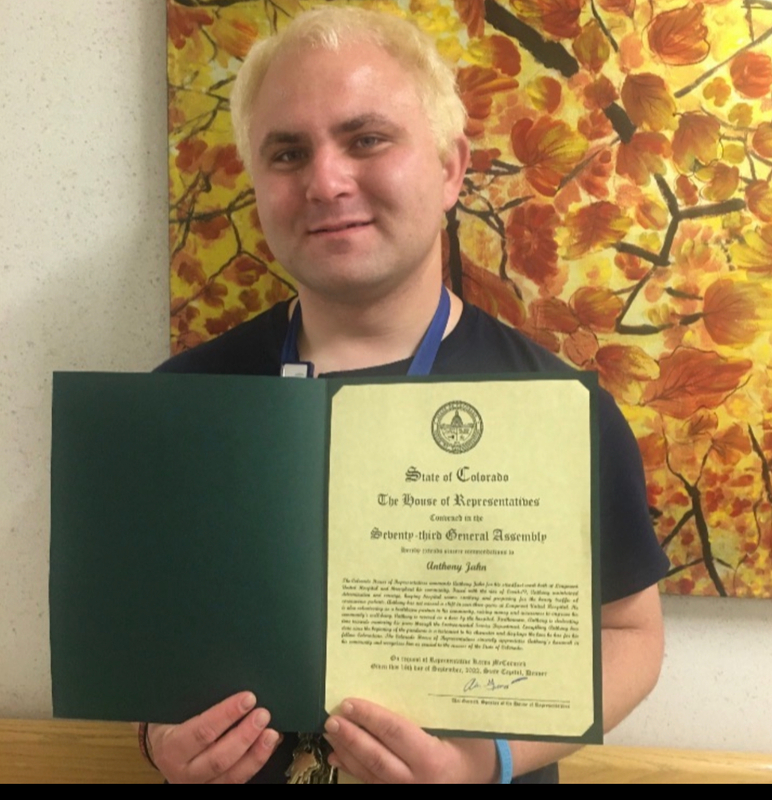 2022-09-22
2022-09-22Anthony
Explains about the warzone in the emergency department doing good during those times to bring people together in the community and a hero being honored by the state of colorado for all his work .This was submit to the house of representatives and this story has been shared in schools such as fredrick highschool by students who look up to him thank you -
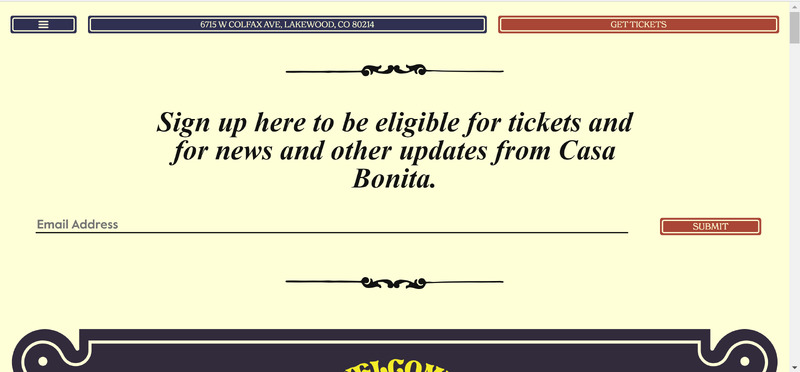 2021-09-16
2021-09-16Hotel California & Casa Bonita
My spouse and I love road trips and concerts. Covid definitely slowed us down! In the summer of 2021, we decided to take a road trip culminating in a concert in Denver, Colorado. Which concert? The Eagles - Hotel California! We drove and camped through Idaho, Wyoming, Utah, and Colorado. In Denver, we toured the famous restaurant Casa Bonita and went to the concert. For the concert, everyone needed a vaccination card and masks were required (although not widely worn). It was fun and felt a little like back-to-normal. We had a great time! -
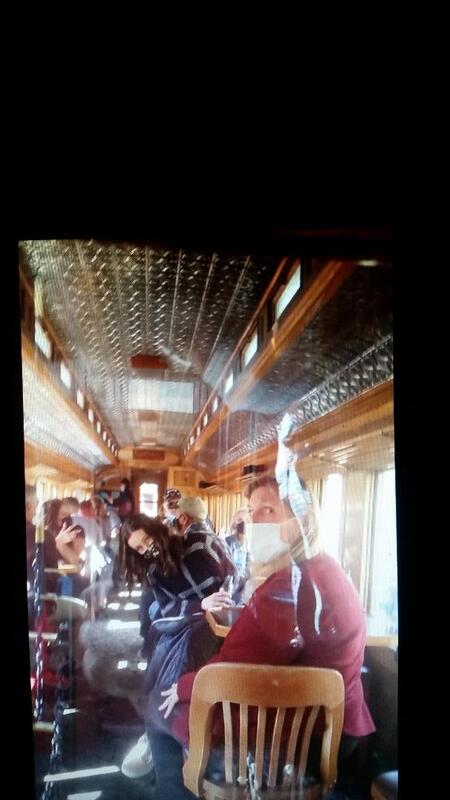 2021-04-12
2021-04-1221st Birthday Trip, Post-Pandemic
My twin sister and I turned 20 right after the beginning of the pandemic in April 2020. That birthday was a gigantic bummer, because all my friends had left my college campus and I was still there but couldn't visit home either due to Covid concerns (my parents are in their 60's and my sister has asthma). So, after a year of not traveling or doing very much else, my first post-covid trip was for my 21st birthday. Not yet ready to get back on airplanes but wanting to do something exciting, my mom, dad, sister, and I packed into the van for an 8-hour drive across Colorado to an Airbnb in Durango, near the southwest corner of the state. Durango is a cute little tourist town that's still sleepy from winter in April, and definitely non-traditional for a 21st birthday bash. We had two objectives for the trip: Mom and Dad were going to buy us our first (legal) alcoholic beverages, and we were going to take a ride on the narrow-gauge railroad that ran from Durango to the nearby tourist/old mining town of Silverton. The first goal was accomplished quickly upon our arrival; we located the old Strater hotel, built in 1887, complete with a bar where we immediately situated ourselves. The servers were dressed like flappers, all wearing masks, many matching the colorful fringes of their dresses. I ordered an old fashioned, was tipsy after half, and handed it off to my mom to finish. My dad had a great time shepherding us back to the van. The train ride the next day was the highlight of the trip. We bought tickets in advance, since only a limited number of seats could be filled in each car due to lingering covid precautions. Masks were also still required, except when eating and drinking (a full bar was available, as well as coffee and pastries). The train crept up into the mountains alongside a river, sometimes crossing over very tall trestle bridges, prompting my mom, who's afraid of heights, to pull her mask up over her eyes. Lunch, which was previously served on the train, was instead provided to us in pre-packaged boxes, to be eaten outside at picnic tables along the river where we were free to spread out and remove our masks. On the ride back to Durango, the full bar on the train was open, and most masks came off. My parents bought my sister and I our second drinks of being 21 (mimosas at 3:30pm, woo!) and we headed back to the Airbnb, stopping to pick up some Serious Texas Barbecue. While Covid ruined my plans for the 21st birthday party I thought I would have, it gave me a few years to slow down and to appreciate my family and small, meaningful, gatherings together, which I wouldn't trade for the wildest party in the world. -
 2022-04-08
2022-04-08Our Roadmap Moving Forward
This is an Instagram post by smcpublichealth. This post is about vaccination status and the risks that they pose. Those unvaccinated are said to be highest risk. The immunocompromised are recommended to see a doctor about a fourth dose. If you are up to date on all vaccines and everyone else in the household is vaccinated, life can continue on as normal. In the hashtags below this post, it says to wear a mask, stay home when sick, and get tested. Obviously, despite it saying that those that are up to dates on vaccines and live with those also fully vaccinated are able to return to normal, culturally, I have seen some people out in public abiding by COVID restrictions. I think this is a hard habit to break, and for some, the feeling of security is worth continuing to wear a mask even if some places have already lifted mandates. My overall feeling from observing those at my own local church is that people are more lenient with mask use based on what the CDC says. A few did not wear masks despite the CDC recommendation, but once the CDC announced masks were not necessary, people at my church took them off. -
 2020-04
2020-04Sounds of a Spring Lockdown
On March 25, 2020 Governor Polis ordered a state-wide stay at home order for Colorado. By this time, my family was already limiting our time outside the house to work or errands. My daughter, Kat, has severe asthma, so we knew we had to limit our exposure as much as possible. Previous midnight trips to the emergency room were full of her wheezing out tiny gulps of air, the beeps and blips of the machine keeping track of her heart rate, and the guttural growl of the blood pressure cuff as it tightened around her arm. These were the sounds I first heard when the stories of a new, novel virus came out, the sounds that stayed most in my mind the more I heard about rising cases. The first week in April the movie theater where Kat worked closed down. My son, Gabe, left his job a few days later. I cried that day, not from sadness but relief. And not a quick cry, but the loud sobs that make your shoulders shake. The next day was a major shift for us. Instead of leaving the house to work, they came to work for me instead. My cross stitch shop was already a full-time business. Now that many people were staying home, the US saw a return to basics (baking and crafting), and my shop exploded with more orders than I could fathom. There is something that satisfies most of us in having that tactile experience, whether it be the feel of flour (soft and powdery) as you knead your bread or the stabstab of your needle piercing your fabric. Though there was the stress of craft stores closing and supply chain delays, long work hours, and boxes of hoops stacked in the living room, there was mostly the sound of the Beatles and loads of laughter. Kat has a high-pitched giggle (she snorts when she really gets going), Gabe a deep laugh rich in tone. Someone came up with the adage that laughter is the best medicine. I couldn’t say who created the saying, but the sound of laughter in my house during the April 2020 lockdown in Colorado kept myself and my children in positive spirits. In fact, our lives have been forever changed by that April. They are back to their old jobs, but we still keep mostly at home and with each other. We have family game nights and cook together and keep the laughter going strong. -
 2021-11-26
2021-11-26HERMIT HERALD, ISSUE 133
Kamala Harris, dazed and confused -
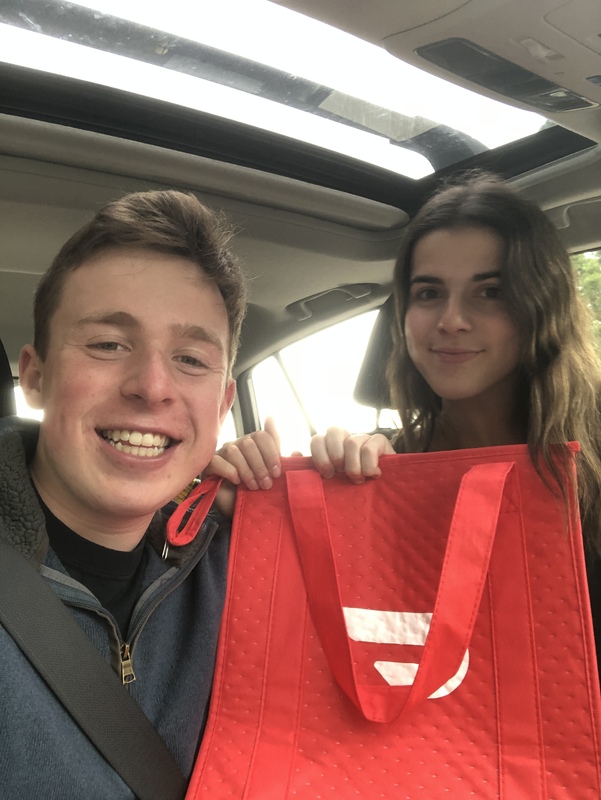 2020-05-30
2020-05-30The Dashathon
When the pandemic quarantine was initially imposed, I found myself with lots of free time on my hands. After weeks of low motivation and extreme boredom, I decided to sign up as a food delivery driver for Doordash, a job that was in high demand at the time. By this point in quarantine, all restaurants were closed for indoor dining, but many were still offering carryout and delivery services, largely through food delivery apps such as Doordash. Some of my friends and I started driving Doordash as frequently as 5-6 nights a week. We strategically prioritized the 4 to 8 PM time-slot in order to cover the majority of the dinner shift. Although it was quite mindless work, it was one of the few things that I had to look forward to as a daily break from the monotonous isolation of quarantine. Orders were frequent and because of the high demand for delivery drivers and very light traffic, tips were generous and reflective of the community’s appreciation for service provided by “frontline workers” like ourselves. After about a month of driving, my friends and I decided to put together a fundraiser called “Dashathon” to support some of our favorite local restaurants and small businesses that were struggling during the pandemic. Because many smaller restaurants did not have the financial resources to operate at a loss during periods of the pandemic, many were forced to shut their doors. Our idea was to reach out to all of our family and friends and designate one night where all of our income and tips from Doordash would be donated to these struggling restaurants and other local charities in need. With lots of outreach, we secured underwriting from 10 different sponsors as well as a dollar-for-dollar match pledge from Doordash itself. Our Dashathon was even highlighted in a television news segment broadcast on the local Denver NBC-affiliate newscast (linked above). We were successful in recruiting over 40 drivers to participate in our event. Through a competition-style format that rewarded the highest earners with gift cards from our sponsors, we were able to raise $15,000 dollars in just four hours. The proceeds were distributed in their entirety to designated local restaurants and charities. -
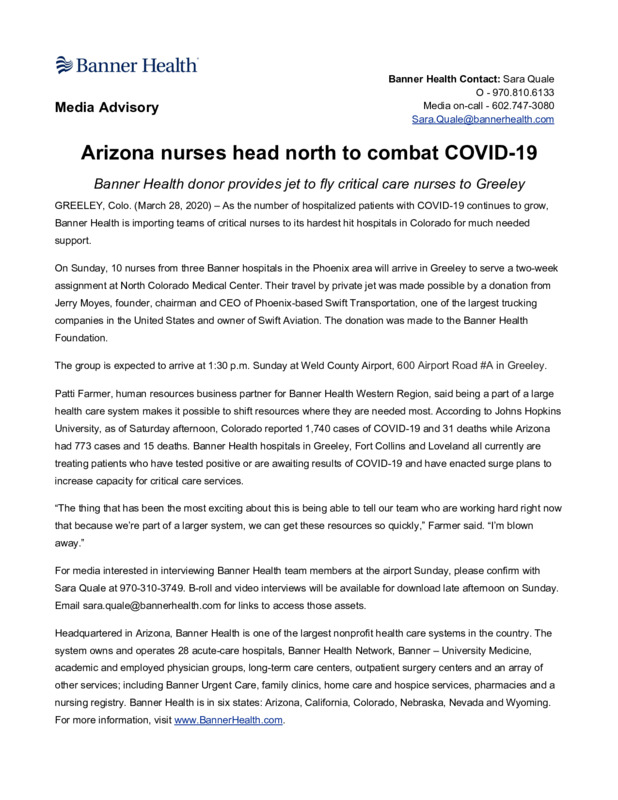 2020-03-29
2020-03-29Arizona nurses head north to combat COVID-19
A press release from Banner Health announcing that ten nurses from three Banner hospitals in the Phoenix area arrived Sunday in Greeley to serve a two-week assignment at North Colorado Medical Center. -
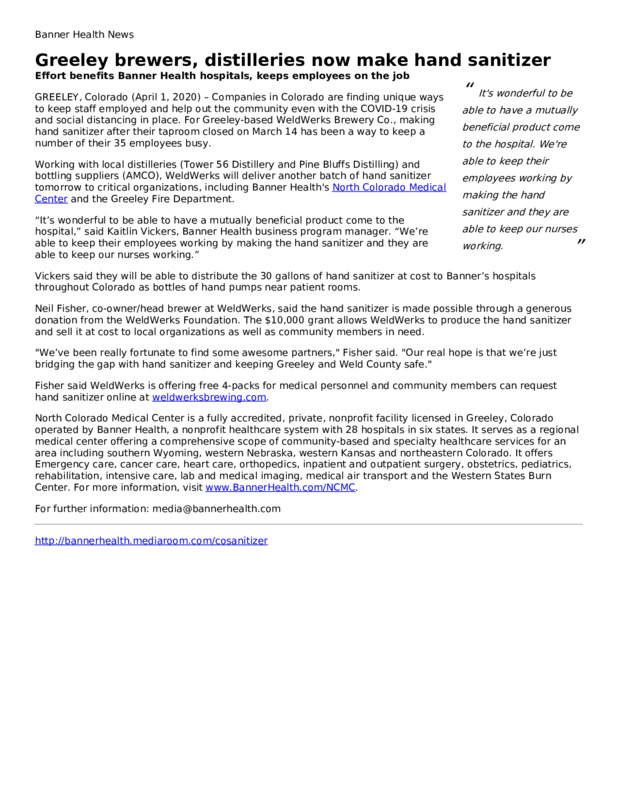 2020-04-01
2020-04-01Greeley brewers, distilleries now make hand sanitizer
A press release from Banner Helath describing efforts and how it benefits Banner Health hospitals, keeps employees on the job -
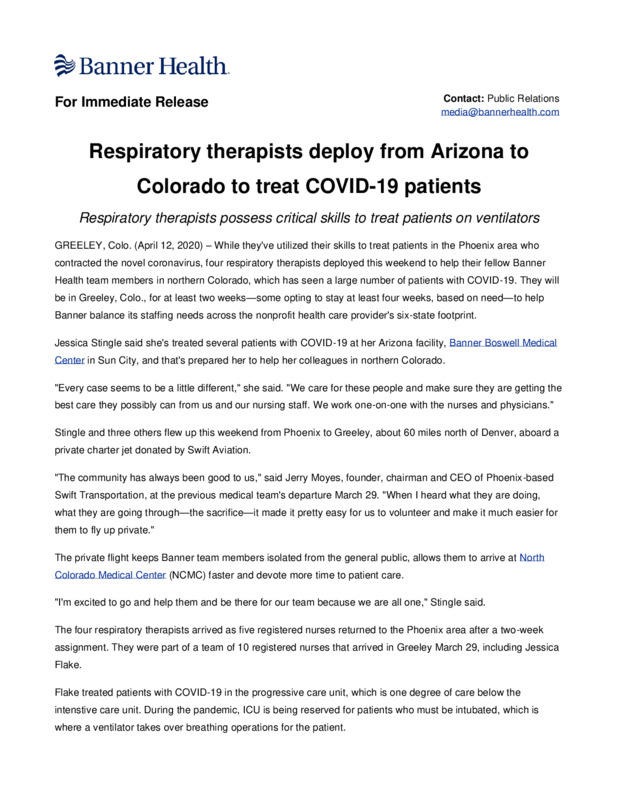 2020-04-12
2020-04-12Respiratory therapists deploy from Arizona to Colorado to treat COVID-19 patients
A press release from Banner Health announcing that four respiratory therapists deployed this weekend to help their fellow Banner Health team members in northern Colorado, which has seen a large number of patients with COVID-19. They will be in Greeley, Colo., for at least two weeks—some opting to stay at least four weeks, based on need—to help Banner balance its staffing needs across the nonprofit health care provider's six-state footprint. -
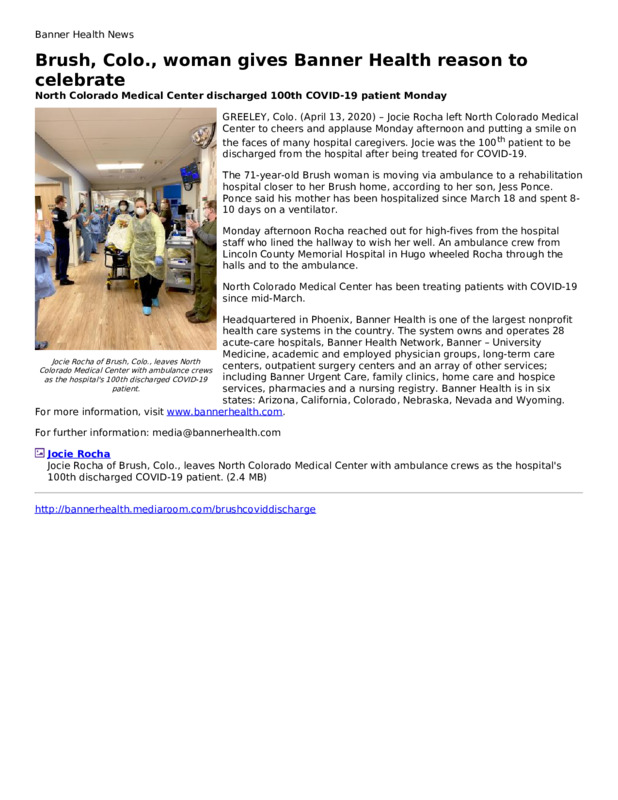 2020-04-13
2020-04-13Brush, Colo., woman gives Banner Health reason to celebrate
Jocie Rocha left North Colorado Medical Center to cheers and applause Monday afternoon and putting a smile on the faces of many hospital caregivers. Jocie was the 100th patient to be discharged from the hospital after being treated for COVID-19. -
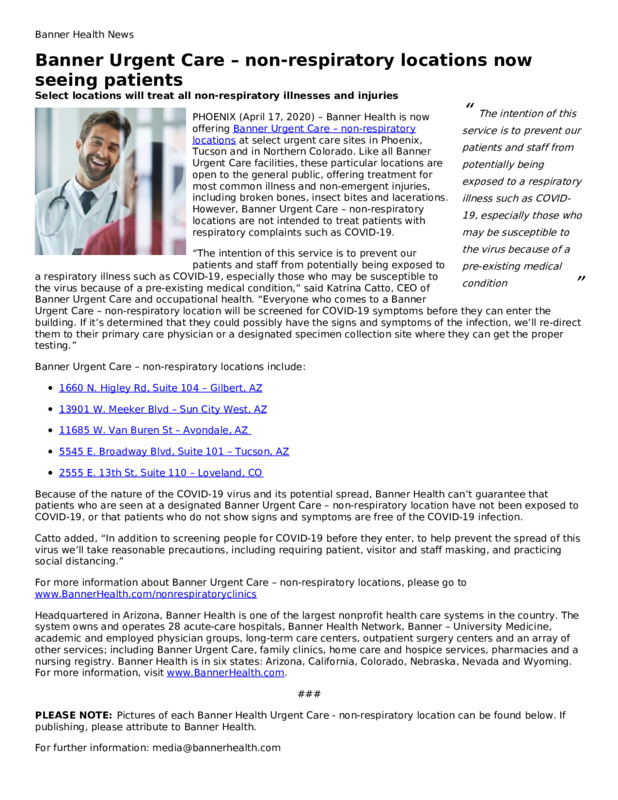 2020-04-17
2020-04-17Banner Urgent Care – non-respiratory locations now seeing patients
A press release from Banner Health announcing that it is now offering Banner Urgent Care – non-respiratory locations at select urgent care sites in Phoenix, Tucson and in Northern Colorado. -
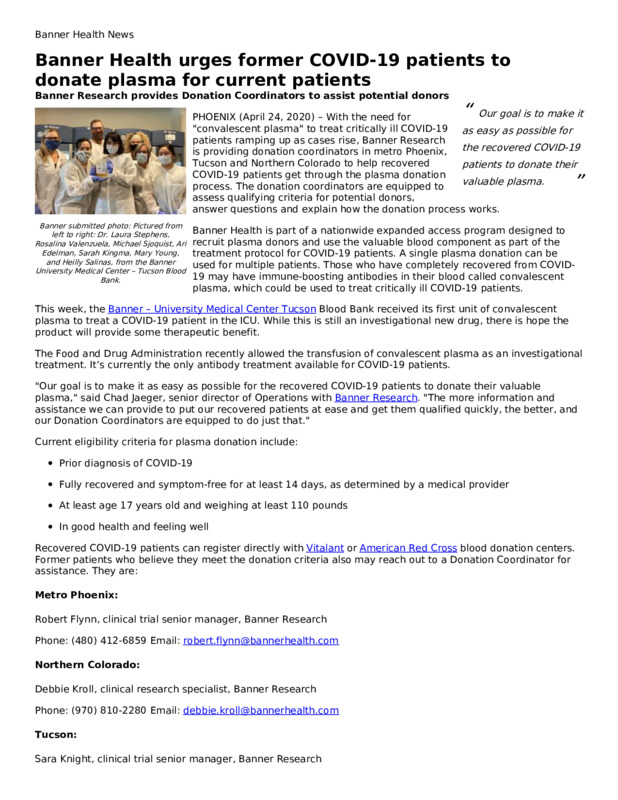 2020-04-24
2020-04-24Banner Health urges former COVID-19 patients to donate plasma for current patients
With the need for "convalescent plasma" to treat critically ill COVID-19 patients ramping up as cases rise, Banner Research is providing donation coordinators in metro Phoenix, Tucson and Northern Colorado to help recovered COVID-19 patients get through the plasma donation process. The donation coordinators are equipped to assess qualifying criteria for potential donors, answer questions and explain how the donation process works. -
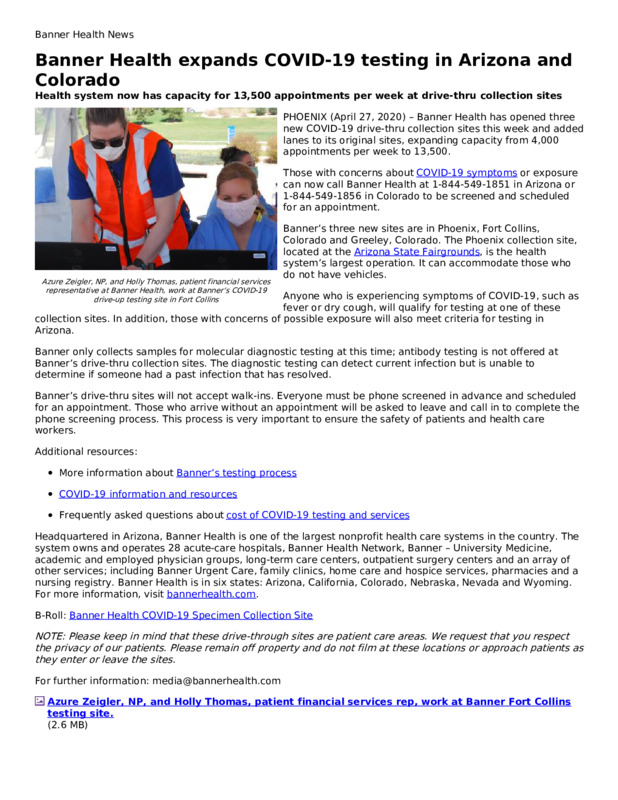 2020-04-27
2020-04-27Banner Health expands COVID-19 testing in Arizona and Colorado
A press release from Banner Health announcing that is has opened three new COVID-19 drive-thru collection sites this week and added lanes to its original sites, expanding capacity from 4,000 appointments per week to 13,500. -
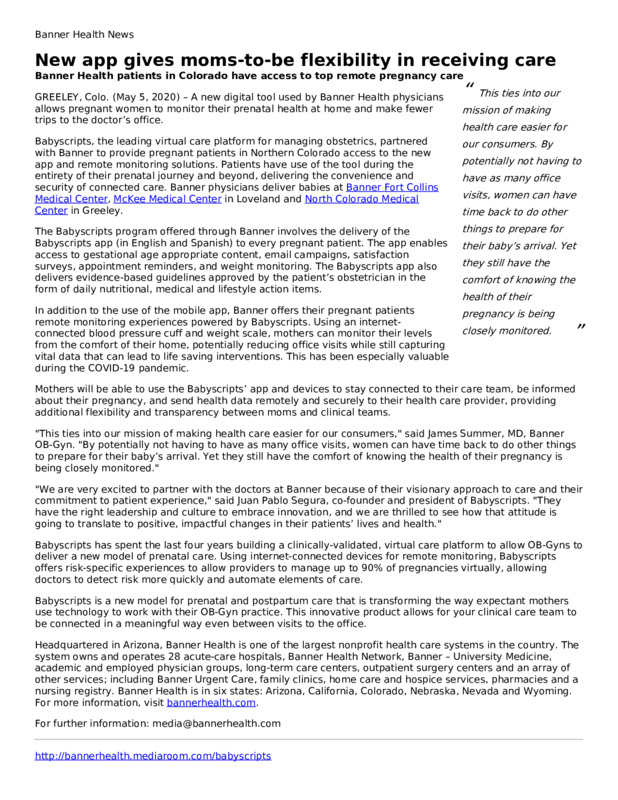 2020-05-05
2020-05-05New app gives moms-to-be flexibility in receiving care
A press release from Banner Health announcing a new digital tool used by Banner Health physicians allows pregnant women to monitor their prenatal health at home and make fewer trips to the doctor’s office. -
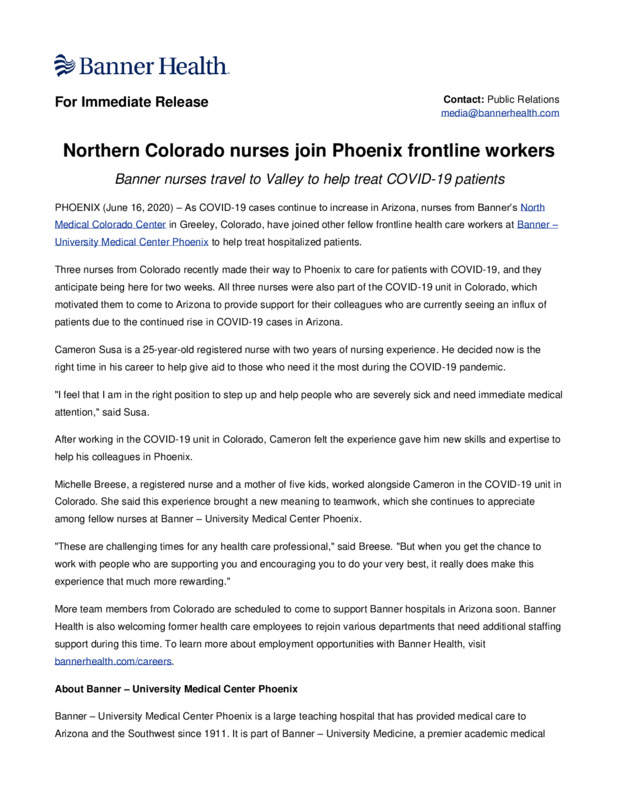 2020-06-16
2020-06-16Northern Colorado nurses join Phoenix frontline workers
As COVID-19 cases continue to increase in Arizona, nurses from Banner’s North Medical Colorado Center in Greeley, Colorado, have joined other fellow frontline health care workers at Banner – University Medical Center Phoenix to help treat hospitalized patients. -
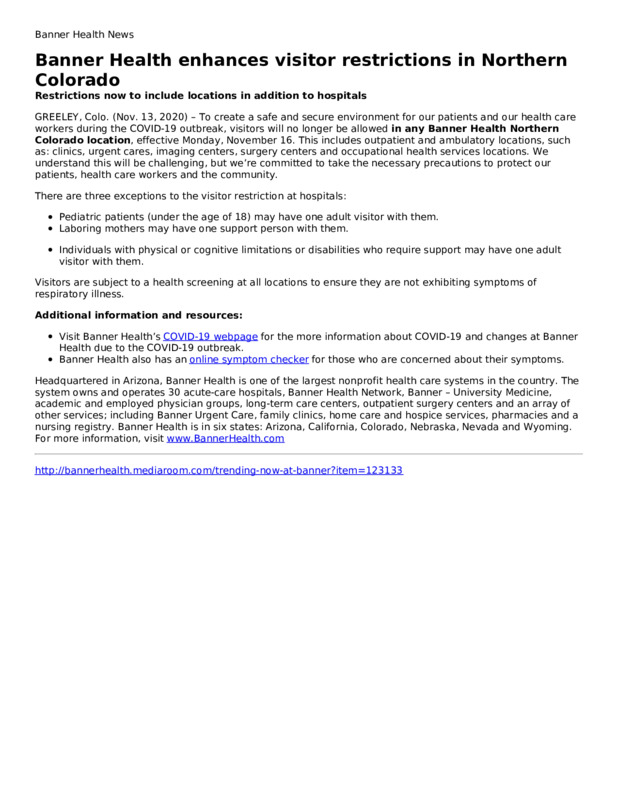 2020-11-13
2020-11-13Banner Health enhances visitor restrictions in Northern Colorado
A press release describing Banner Health enhances visitor restrictions in Northern Colorado -
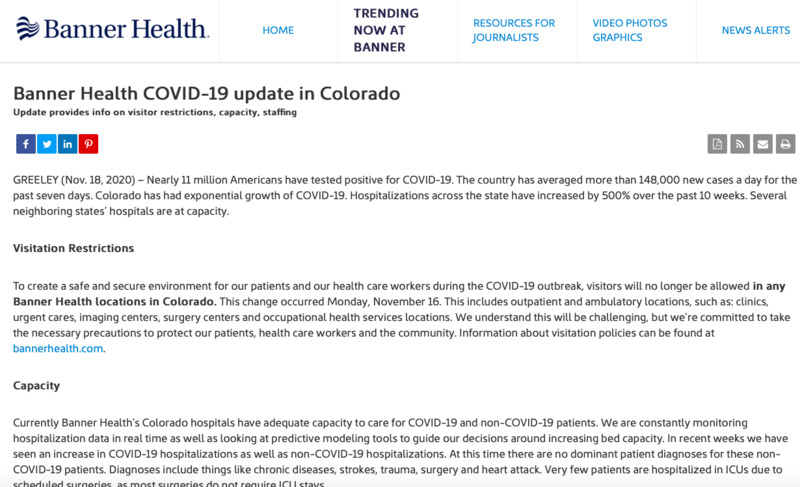 2020-11-18
2020-11-18Banner Health Update in Colorado
Banner Health enhances visitor restrictions in Northern Colorado. Restrictions now to include locations in addition to hospitals -
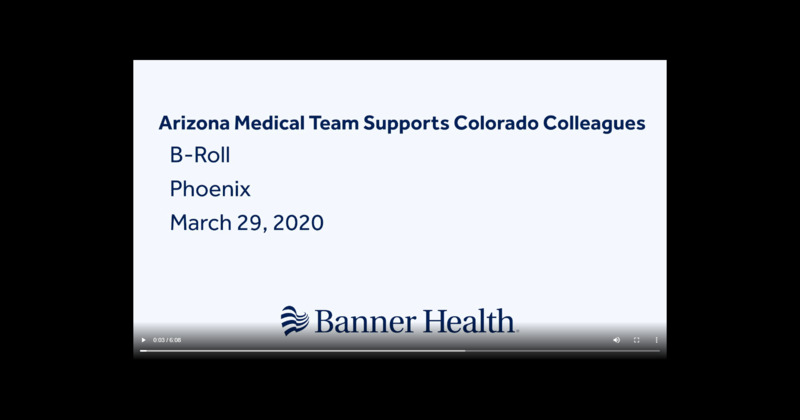 03/29/2020
03/29/2020Arizona nurses support Colorado colleagues
Ten nurses from Banner Health’s Arizona hospitals are heading to northern Colorado to assist their colleagues at the Banner-owned hospital in Greeley, North Colorado Medical Center. -
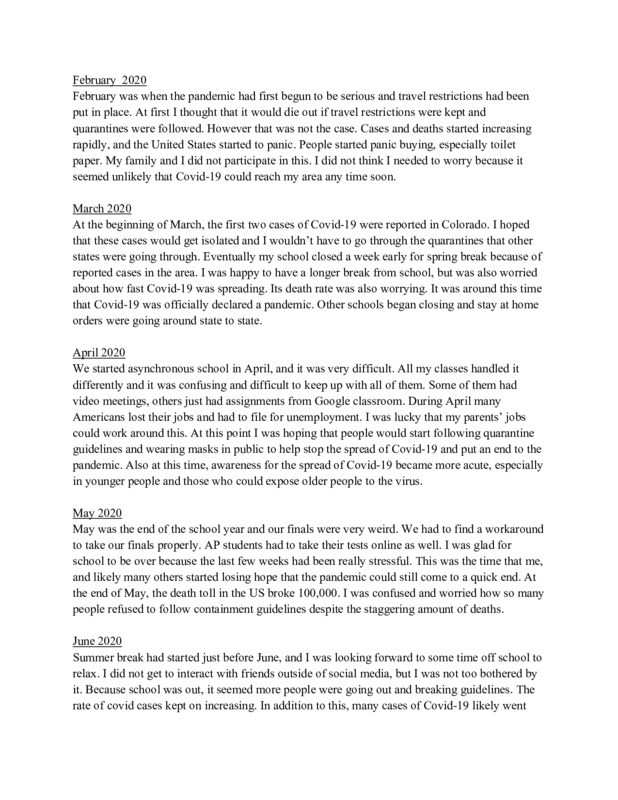 2021-05-26
2021-05-26How Covid-19 affected me
This is a journal-like document that describes what happened to me and how I felt each month of the duration of the pandemic. -
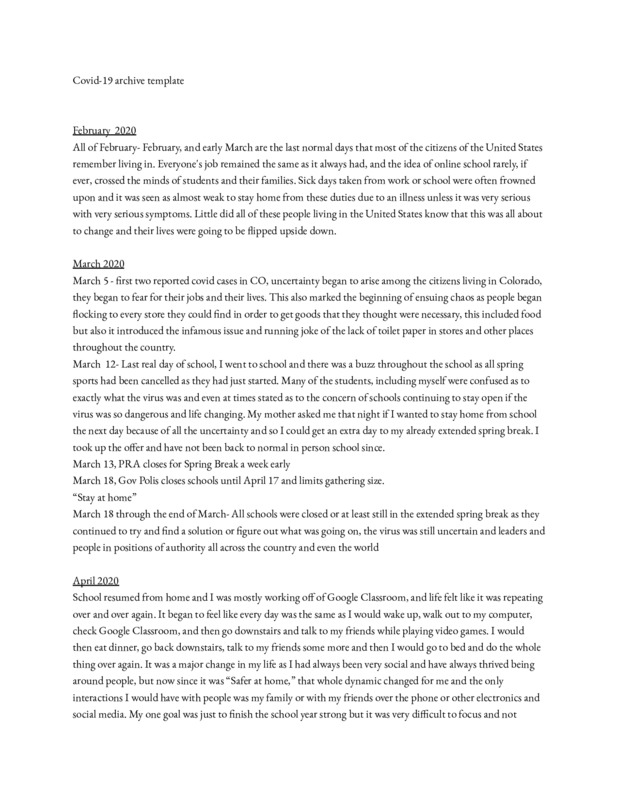 2021-05-22
2021-05-22Life as a High Schooler During Covid-19
The story talks about my experience and what it was like to be a high schooler during the pandemic and how there were many struggles involved. -
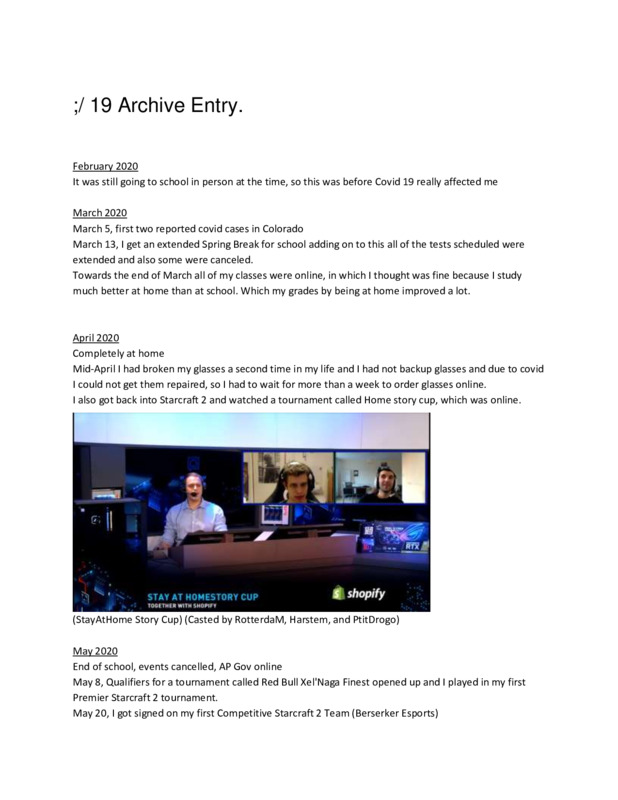 2021-05-25
2021-05-25Covid 19 archive entry (Starcraft Edition)
What this mainly shares my experience with my esports team during the pandemic and also how my social life changed during the pandemic. The object is to talk about how I made new friends and also how Covid 19 wasn't the only world wide issue, and example would be the crisis in Myanmar. -
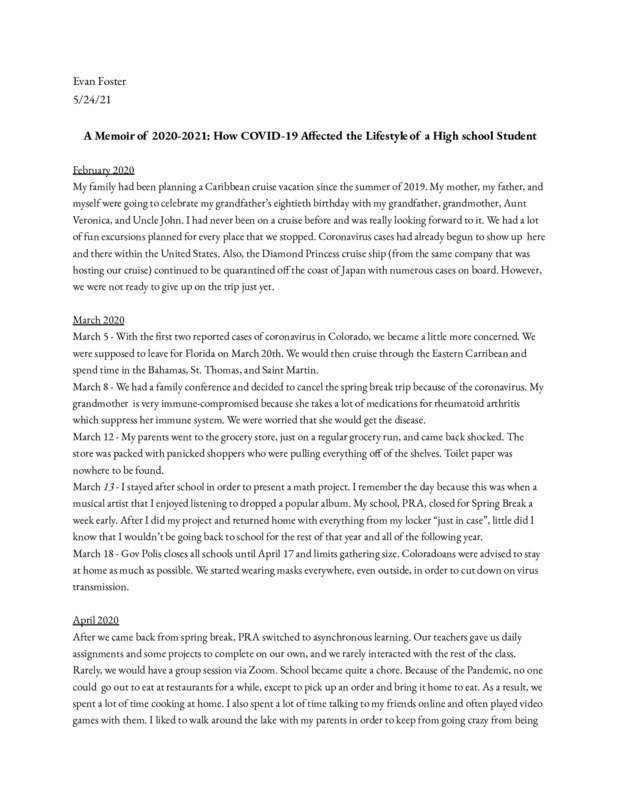 2021-05-24
2021-05-24A Memoir of 2020-2021: How COVID-19 Affected the Lifestyle of a High school Student
The PDF tells the story of my life over the years from 2020-2021. It explains how covid affected the lifestyle of a high school student, with many other added details. -
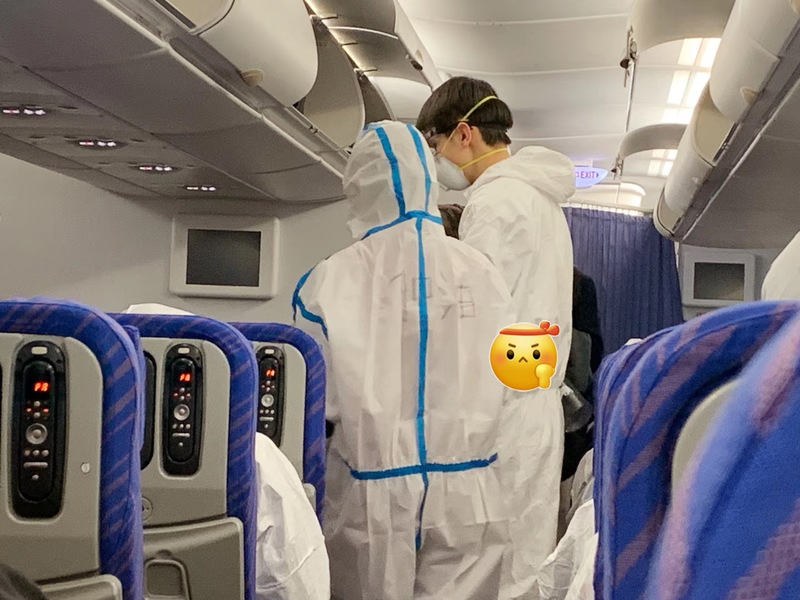 2020-03-26
2020-03-26A Long Way Home
As an international student from China, one of my most impressive experiences about COVID-19 was the long journey when my friends and I returned home from Denver to Beijing. We knew this journey home is bound to be challenging since it happened at such a particular time. The first challenge we faced is to make preparation for the flight. Getting on a flight successfully is largely a matter of luck, as you never know if your flight will be canceled just before the departure date. Due to changing flight policies, our tickets were canceled three times. At that time, my friends and I felt deep powerlessness in the unstable situation. Fortunately, after the fourth flight adjustment, we successfully boarded the journey home. To prevent being infected by coronavirus at the crowded airport, we armed ourselves to the teeth. We wore medical gloves and masks, raincoats (because protective suits were sold out), and we even prepared ski goggles since the safety goggles were sold out too. During the 18 hours on the plane, we just ate a few bars of chocolate and drank some water. And that was the second challenge we faced. However, thanks to the company and encouragement of my two friends that made our time on the plane less stressful and depressed. When we arrived wearily in Guangzhou, we found out a new policy just published that requires returnees to be quarantined as soon as they got off the plane. Therefore, we had to cancel the ticket from Guangzhou to Beijing. As soon as we got off the plane we were taken to a local hotel where we are going to be quarantined for 14 days. During the quarantine, I went through an experience I never had before. Food is delivered to us every day by staff wearing protective suits. And we measured our body temperature at regular intervals every day. In order to overcome the loneliness during the 14 days, my friends and I created an online meeting room, which made us feel that we are eating and studying together. Finally, 16 days after leaving Denver, my friends and I returned to our hometown Beijing. For me, there is nothing happier than seeing my parents in person and eating food cooked by them! My friends and I grew up a lot after going through this experience. This long way home taught us the importance of adjusting mood and supporting each other in times of crisis. -
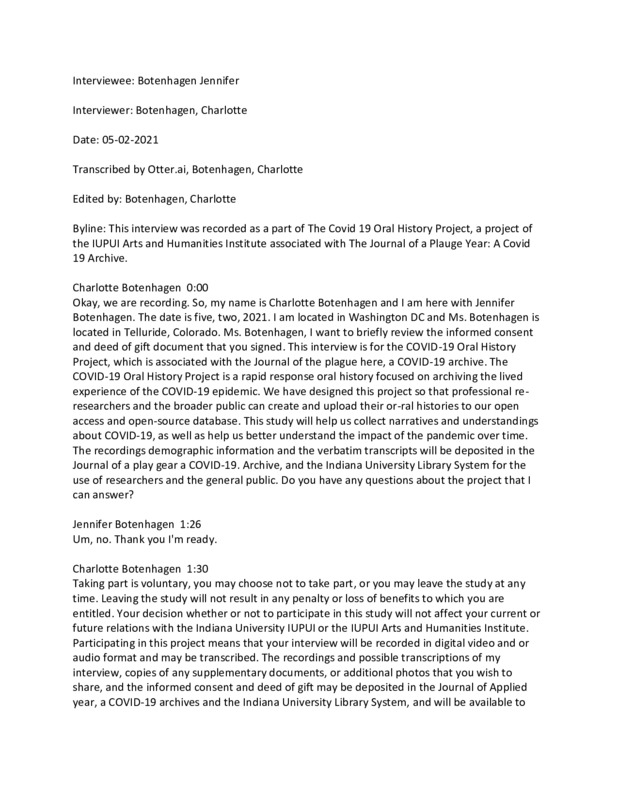 2021-05-02
2021-05-02Charlotte Botenhagen Oral History, 2021/05/02
This was an interview from Jennifer Botenhagen who is a preschool teacher living in a tiny mountain town. This interview details her experience adapting to teaching during the COVID-19 pandemic. -
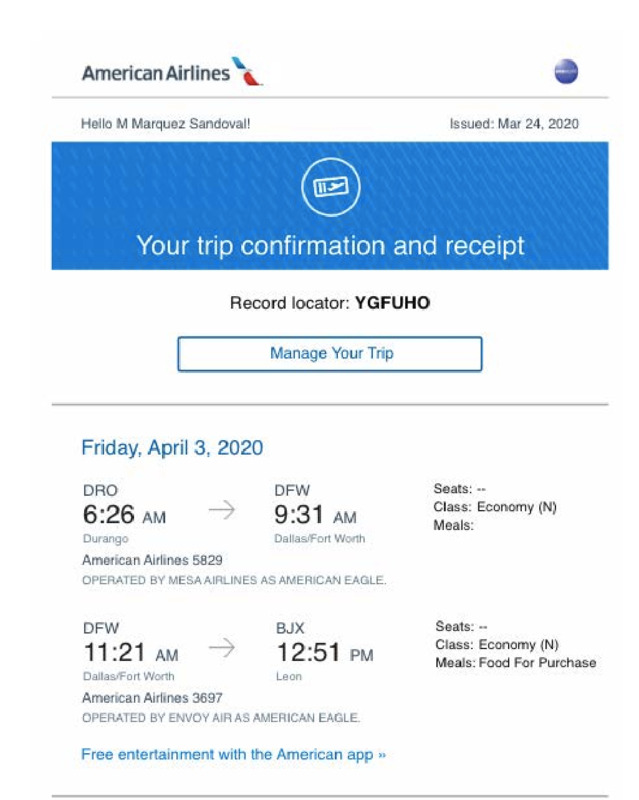 2020-04-08
2020-04-08Flying home on COVID times
In March 2020, when the COVID-19 pandemic arrived in the USA I was a history teacher at Fort Lewis College in Durango, Colorado. When the stay-at-home order was issued by Colorado's government and FLC confirmed classes online only I was eager to come back to my home country, Mexico. After my boss's approval, I proceed to purchase my flight ticket. Prices were constantly changing even on the same day. One ticket could go from over $600 around 8 am, to $450 at noon and less than $300 by the afternoon. Other days ticket were more expensive in the morning and less by the evening. I originally purchased my ticket for the end of April but when rumors of a potential USA's close of borders increased, I changed my ticket for April 3 to prevent more stress about the potential risk of being stranded at Durango's or Dallas's airport. I profited from the no-cost policy to change plane tickets and went ahead. The mood at both airports was eerie with very few travelers. Even the usually overcrowded Dallas Airport looked empty. Passengers at waiting rooms were scarce and food vendors were hard to find as most of them were closed. The few open had blocked their seating sections. To find my boarding room was very hard as it was constantly changing within few minutes. To board my international American Airlines Flight 3697 from Dallas to Guanajuato, Mexico, I walked from one side to another and took the train to another terminal. By the time I had arrived it was already changed again. Surprisingly my American Airlines Flight 3697 had plenty of passengers. I could not identify a single non-Latino traveler. It seems that most passengers were Mexican nationals or descendants. I paid a small difference to be upgraded to First Class and I was very pleased that few passengers chose that class. Nobody sat beside me or in the other section after the corridor. However, as previously announced and confirmed at boarding, no meals or beverages were going to be supplied at all during the flight. Boarding had no problems, although I noticed there were no police officers at boarding, as usually happens on flights to Mexico, nor a double safety search was made. The flight went smoothly and once I arrived on time at Guanajuato International Airport I noticed that a lot of passengers were not wearing masks, and they were not mandatory at the flight nor at the airport. I had mine. Once we passed Mexican' Customs, passengers were told to do two lines for Mexican and Non-Mexican travelers to pass a health inspection. We had to fill out a questionnaire about our activities of past days and if we had any fever or cold-related symptoms or if we had contact with someone sick. Depending on your answers you were put in a different room, but for me, that answered negatively all questions, I met with a nurse who scanned my temperature on my forehead and requested my address, email, and phone number. I was strongly recommended to self-quarantine at home for at least 14 days, which I did. My husband was waiting for me at the airport and regardless of what we were doing in the USA, I did hug him and saw other passengers did as well with their families picking them up at the airport. For some moments COVID policies did not apply to our beloved ones! -
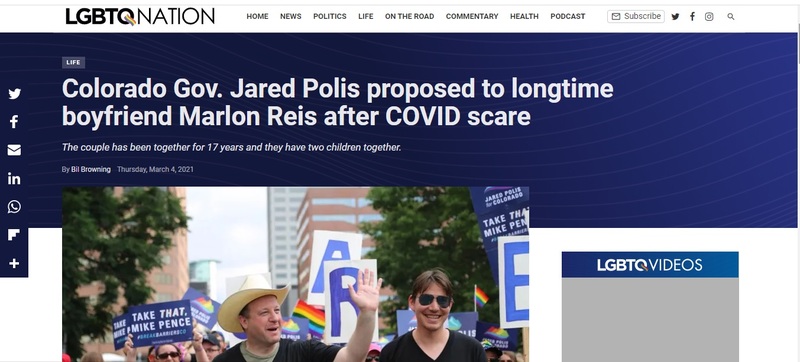 2021-03-04
2021-03-04Colorado Governor Jared Polis Gets Engaged
The Governor of Colorado Jared Polis proposes to his boyfriend of seventeen years Marlon Reis due to their COVID-19 diagnosis where one of them had to be hospitalized. Members of Congress in his state had issues with him getting engaged to his longtime boyfriend due to their conservative views and the governor's response to the pandemic. The two long-time partners have two children together as well. Some residents of Colorado showed hate towards the Governor's news as he was an open and out government official and was the first Gay Colorado Governor in history. -
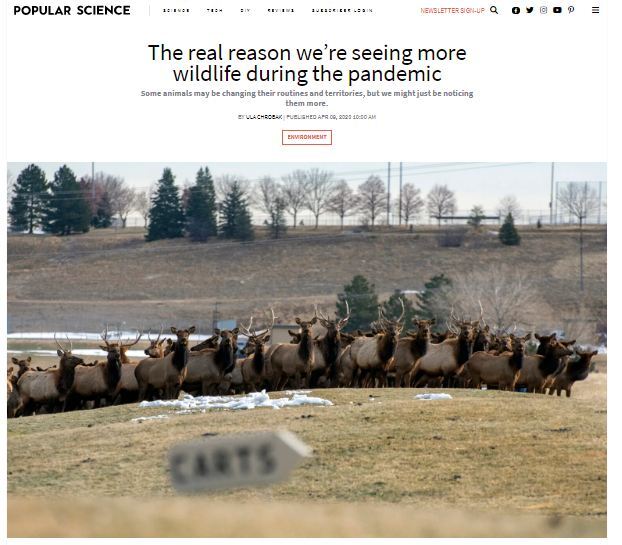 2020-04-09
2020-04-09Why are we seeing more wildlife during the pandemic
This article is important because it discusses why we are seeing more wildlife out and about during the pandemic. They discuss the topic of “is more wildlife out, or are people just noticing wildlife more?” and other topics related to this. This article also discusses the difference between seeing bigger or smaller animals and the reasoning behind it. This article gives a good insight on wildlife during the pandemic and reasons for more sightings. -
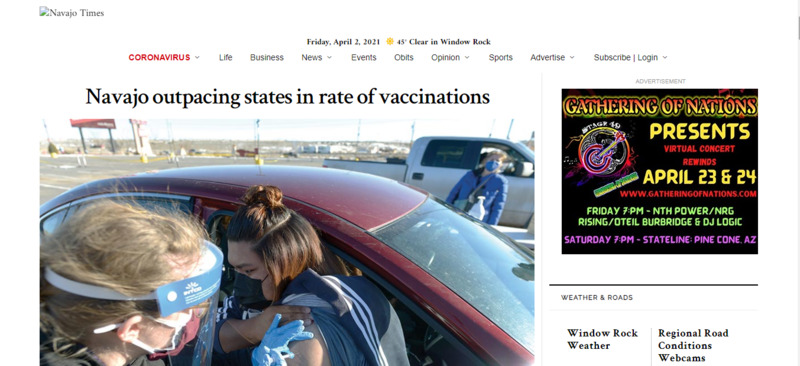 2021-03-09
2021-03-09Navajo Nation outpacing states in rate of vaccinations
By Rima Krisst | Mar 9, 2021 | CORONAVIRUS, News | WINDOW ROCK President Jonathan Nez proudly said last week that the Navajo Nation had exceeded its goal of administering 100,000 COVID-19 vaccine shots by end of February, crediting tireless health care workers who have been serving seven days a week to plan vaccinations and administer the vaccines. On Tuesday, the president’s office reported that 135,161 COVID-19 vaccine shots have gone into arms on the Navajo Nation, which represents 92% of the total 146,980 doses received and includes 48,800 persons who have had their second shots. This means that over 26% of the approximately 327,000 enrolled Navajos have gotten a shot through the Navajo Area Indian Health Service and tribal health care system, which is an amazing feat. By comparison, in New Mexico 22.4% of the population (738,705) has been given at least one shot. Arizona has administered at least one shot to 17.1% of the population (1,847,750), with Utah trailing behind at 12.2% receiving at least one shot (687,925), according to the CDC data vaccine tracker. And as of March 2, 15.3% of the U.S. population had received at least one shot, with 76.9 million shots administered, including 25.4 million receiving the second dose. Approximately 1.8 million vaccines per day are being administered daily in the U.S. So, percentage-wise, Navajo is outpacing both neighboring states and the general U.S. population. ‘Amazing partnership’ On a Feb. 25 IHS media call, IHS Chief Medical Officer Rear Adm. Michael Toedt reported that as of Feb. 18 the IHS had also achieved its goal of administering 400,000 doses of COVID-19 vaccine “across IHS, tribal, and urban Indian Health programs,” representing 16% of the “target population,” with 6.3% receiving two doses. “This milestone was reached ahead of schedule despite severe weather, making travel to health facilities difficult across much of Indian Country and leading to shipping delays,” said Toedt. Toedt said most IHS facilities have now vaccinated the majority of their priority populations and are moving into Phase 2, which includes those who work in higher risk settings such as schools and prisons. “Very shortly we expect that everyone who needs a vaccine will be able to receive it,” he said. Toedt credited IHS and tribal health care employees across the country who are committed to ensuring the protection of tribal communities in 11 geographic areas covering 26 states and 349 health facilities, many in rural and remote locations. “We have had an amazing partnership with our tribes to use all available resources to help with delivery of vaccine,” said Toedt. This included distribution and redistribution of vaccines by ground and air transportation as needed. Toedt said the IHS has also conducted over 2 million COVID-19 tests at a higher per capita than most states and is reporting a seven-day average test positivity rate of 4.5%, below the 5.6% all-races rate in the U.S., despite the fact that COVID-19 has had a disproportionate impact on American Indians/Alaska Natives. The Navajo Nation has conducted 245,085 COVID-19 tests resulting in 29,774 positive cases. ‘Developing trust’ Coordinated public relations campaigns in partnership with tribes have been key to the success of the vaccine rollout, said Toedt. Navajo Area IHS Chief Medical Officer Loretta Christensen agreed, saying public messaging has been critical. “This collaboration is one of the reasons we’ve been extremely successful,” said Christensen. “Honesty and transparency, developing that trust with the people you are serving is vital. We have spent a great deal of time on that relationship with our Navajo people to encourage them to be vaccinated.” She said the communication process has been very unified across Navajo and with the president’s office, using social media, radio, and a bilingual approach. “This is constant public education,” she said. “We encourage people in a very personal way that we would like them to be safe, keep their families, their communities safe. We feel very fortunate and grateful that our population has really stepped up.” Toedt acknowledged there has been some vaccine hesitancy relating to how quickly the vaccines were developed and whether or not they are completely safe, which has made some people distrustful. According to IHS Public Affairs Specialist Joshua Barnett, a recent IHS-funded survey by the Urban Indian Health Institute reported that 75% of Native Americans were willing to get a vaccine and 74% believe that doing so is their responsibility to help protect their community. “I’m confident that the process for vaccine development has the full integrity and completeness of time necessary to make sure these vaccines are safe, but it’s our job as healthcare providers to communicate that in a way that’s acceptable and trusted by our population,’ said Toedt. “We know our efforts are working and we’re seeing good delivery and acceptance of these vaccines in our communities.” Reaching the homebound Christensen said one of the strongest assets in the Navajo vaccination campaign has been the collaboration between public health nurses and community health representatives in reaching out to community members at the local level, including homebound elders and persons with disabilities. “These are the people out in the rural areas that know the families, that know the homes,” said Christensen. “We rely on them for that person-to-person contact out in the communities.” She said between 4,000 to 5,000 homebound individuals have actually been vaccinated at home or close to home. Moving forward with the goal of getting the Navajo population vaccinated and achieving “community immunity,” Navajo Area IHS wants to make sure that all 27,000 square miles of the Nation have been penetrated, said Christensen. “We want to be able to target any communities, populations or subgroups that have perhaps maybe not been able to get vaccinations,” she said. “So, our first step is to heat-map our whole area and then focus on those populations that are perhaps more rural or don’t have easy access to healthcare facilities.” “Our goal is to get every single person vaccinated and to keep our populations in Arizona, New Mexico and Utah safe,” she said. Christensen said her team will be working with chapters to identify anyone who might have been missed. They have also reached out to Navajos living off reservation and have established an online registry to help people find a place to get their vaccination. “We highly encourage them to come back if they need to and we will certainly take care of them and their families,” she said. Tracking variants In regard to surveillance for COVID-19 variants, Toedt said IHS does contribute its tests to state public health labs as well as different large lab corporations such as TriCore, LabCorp. and additional processes for genomic testing are in development. “The samples that are included through those mechanisms are sampled through the CDC’s processes to test for genomics,” said Toedt. Christensen said similarly the Navajo Area and the Health Command Center are working to establish more specific genomic surveillance within Navajo Nation. “In the meantime, we are participating in testing both in New Mexico and Arizona,” said Christensen. Christensen said the Navajo Epidemiology Center has also reached out to bordering states requesting any relevant information on variants be shared. “We all stand by ready to support this process and we are hopeful that we will have more specific information for Navajo Nation very soon,” she said. Christensen confirmed that she was not aware of any variants having been identified on the Navajo Nation from random sampling. “We have requested that information but we have not received it as of yet,” she said. Adverse events Any adverse events, or serious side effects, related to vaccinations within IHS are collected and reported to the same CDC system that collects the data nationally, said Toedt, but the data broken down by individual tribes is not publicly available. “We are part of that Vaccine Adverse Event Reporting System through the CDC,” said Toedt. “All adverse drug reactions are investigated by the CDC to determine what category it goes in and how they analyze data.” Navajo Area is gathering information on any adverse events on the Navajo Nation, but there are patient privacy issues when it comes to sharing that publicly, said Christensen. “We do, as (health care) institutions across Navajo Nation, share basic data with each other when we’re doing best practices,” she said. Christensen would not answer whether or not there had been any adverse events on the Nation. “I will say we have done very well with these vaccines,” she said. “There are certainly side effects which have been well defined, but we’ve had minimal significant adverse events. I cannot quantify that for you, but we are tracking those events across Navajo Nation.” Preventing transmission As far as keeping everyone safe after being vaccinated, Toedt said it’s still important to continue to wash your hands, stay six feet apart and to wear a mask. This is because vaccinated persons can theoretically still contract COVID-19 and spread it after being vaccinated, although they may not have any symptoms due to protection from the vaccine. There are also still many unknowns related to COVID-19 variants and to what extent they may evade vaccine protection, be more transmissible, or cause more serious disease. “We have been trying to report on possible variants most recently, explaining that we don’t have all the information yet on what the long term effects of those variants are,” said Christensen. “So we highly suggest that you still watch your distance, wash your hands and wear your mask.” Christensen said public messaging encouraging everyone to abide by the public health protocols in place, regardless of vaccination status, will continue until there is community immunity. -
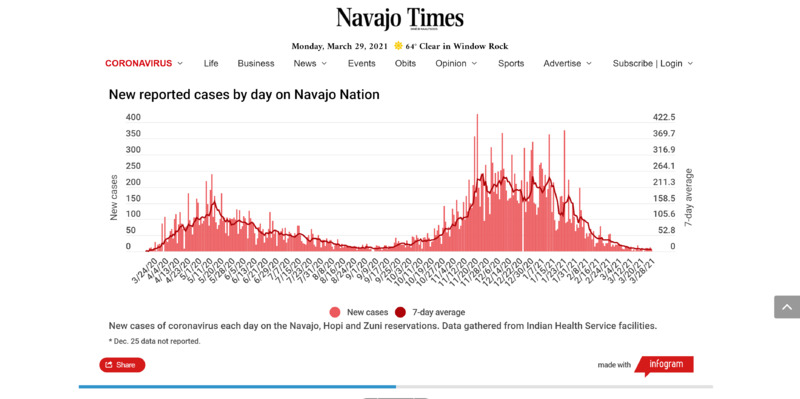 2021-03-29
2021-03-29In numbers: Tracking COVID-19 Across the Navajo Nation
In numbers: Tracking COVID-19 Across the Navajo Nation By Navajo Times | Mar 29, 2021 | CORONAVIRUS | On Sunday, Navajo Nation health officials reported 7 new COVID-19 cases. A total of 30,059 people have been sickened by the coronavirus. The rate of decrease in new cases is slowing. Nevertheless, the seven day average is 7 new cases per day, a decrease of 30 percent from the average two weeks earlier. On a per-capita basis, about 3 cases for every 100,000 people on the Navajo Nation are active. This means the Navajo Nation has the lowest per-capita cases anywhere in the 50 U.S. states. No new deaths were announced, leaving the total at 1,246 casualties of the virus. At least 16,342 people on the Navajo Nation have recovered. More than 8 of 10 people on the Navajo Nation have received at least one dose of the vaccine, or 86.3 percent of the population as of March 26, according to the Navajo Area Indian Health Service. A spokesperson for the Navajo Area IHS says 244,209 people get health care from it. Of those, 196,902 have received at least their first dose of a COVID-19 vaccine. That number includes 88,891 people, or 36.4 percent, who are fully vaccinated, according to the spokesperson. Caution is still warranted: Highly contagious variants of the virus continue to spread. The more lethal U.K. variant is doubling every 10 days throughout the United States. It now represents more than half of new U.S. cases. Many jurisdictions near the Navajo Nation are relaxing COVID restrictions. Some health experts warn that easing up right now is too soon. It could lead to an increase in new cases. Health experts recommend continued vigilance in wearing masks, social distancing, avoiding socializing with people outside your immediate household, and hand-washing. Double-masking also is recommended. For those who are fully vaccinated, the CDC still recommends wearing a mask and hand-washing; although social restrictions are more relaxed. Follow this link for complete CDC guidance for those who are vaccinated: https://www.cdc.gov/coronavirus/2019-ncov/vaccines/fully-vaccinated.html Although the Navajo Nation has relaxed some restrictions, a daily curfew remains in efffect from 10 p.m. to 5 a.m. Businesses may remain open until 9 p.m. timeline Positive Test Rate The estimated percentage of people who tested positive was 1.2 percent on Sunday. The 7-day average positive test rate was estimated at 1.9 percent. The World Health Organization recommends a 7-day average positive test rate of less than 10 percent for two weeks in a row. Localities that have a test rate of 3 percent or less are most successful in containing COVID-19, according to the WHO. At Hopi, one new cases was reported overnight, bringing the total to 1,376. The Hopi radio station reported on its Facebook page that at least 120 people have died since the pandemic began last year, but the Hopi Tribe has not consistently reported fatalities from the virus. The following charts and maps show the extent and location of the coronavirus on and near the Navajo Nation. Hover over, tap or click the map markers and graph for expanded information. (Last updated March 29, 2021 at 10:44 a.m. MDT.) Growth of COVID-19 on Navajo Nation and Hopi Reservation Cases April 2020 June 2020 August 2020 October 2020 December 2020 February 2021 0 10,000 20,000 30,000 40,000 Number Date Cases Mar 16, 2020 2 Mar 18, 2020 3 Mar 20, 2020 14 Mar 21, 2020 26 Mar 23, 2020 29 Mar 24, 2020 39 Mar 25, 2020 69 Mar 26, 2020 71 Mar 27, 2020 92 Mar 28, 2020 115 Mar 29, 2020 128 Apr 1, 2020 214 Apr 2, 2020 214 Apr 4, 2020 321 Apr 5, 2020 354 Apr 6, 2020 384 Apr 7, 2020 426 Apr 8, 2020 488 Apr 9, 2020 558 Apr 10, 2020 597 Apr 11, 2020 698 Apr 13, 2020 813 Apr 14, 2020 838 Apr 15, 2020 921 Apr 16, 2020 1,042 Apr 17, 2020 1,127 Apr 18, 2020 1,197 Apr 20, 2020 1,206 Apr 22, 2020 1,282 Apr 23, 2020 1,360 Apr 24, 2020 1,540 Apr 25, 2020 1,637 Apr 26, 2020 1,716 Apr 27, 2020 1,769 Apr 28, 2020 1,873 Apr 29, 2020 1,977 Apr 30, 2020 2,141 May 1, 2020 2,292 May 2, 2020 2,373 May 4, 2020 2,474 May 5, 2020 2,559 May 6, 2020 2,654 May 7, 2020 2,757 May 9, 2020 2,976 May 10, 2020 3,122 May 11, 2020 3,202 May 13, 2020 3,392 May 14, 2020 3,632 May 15, 2020 3,740 May 16, 2020 3,912 May 17, 2020 4,002 May 18, 2020 4,071 May 19, 2020 4,153 May 20, 2020 4,253 May 21, 2020 4,434 May 22, 2020 4,529 May 23, 2020 4,633 May 24, 2020 4,689 May 25, 2020 4,794 May 26, 2020 4,842 May 27, 2020 4,944 May 28, 2020 5,044 May 29, 2020 5,145 May 30, 2020 5,250 May 31, 2020 5,348 Jun 1, 2020 5,479 Jun 2, 2020 5,533 Jun 3, 2020 5,661 Jun 4, 2020 5,730 Jun 5, 2020 5,808 Jun 6, 2020 5,918 Jun 7, 2020 6,020 Jun 8, 2020 6,110 Jun 9, 2020 6,150 Jun 10, 2020 6,275 Jun 11, 2020 6,378 Jun 12, 2020 6,470 Jun 13, 2020 6,554 Jun 14, 2020 6,611 Jun 15, 2020 6,633 Jun 16, 2020 6,672 Jun 17, 2020 6,747 Jun 18, 2020 6,832 Jun 19, 2020 6,894 Jun 20, 2020 6,963 Jun 21, 2020 6,990 Jun 22, 2020 7,045 Jun 23, 2020 7,088 Jun 24, 2020 7,157 Jun 25, 2020 7,278 Jun 26, 2020 7,320 Jun 27, 2020 7,414 Jun 28, 2020 7,469 Jun 29, 2020 7,532 Jun 30, 2020 7,549 Jul 1, 2020 7,613 Jul 2, 2020 7,669 Jul 3, 2020 7,733 Jul 4, 2020 7,804 Jul 5, 2020 7,840 Jul 6, 2020 7,914 Jul 7, 2020 7,941 Jul 8, 2020 7,981 Jul 9, 2020 8,042 Jul 10, 2020 8,098 Jul 11, 2020 8,124 Jul 12, 2020 8,187 Jul 13, 2020 8,243 Jul 14, 2020 8,290 Jul 15, 2020 8,370 Jul 16, 2020 8,486 Jul 17, 2020 8,536 Jul 18, 2020 8,568 Jul 19, 2020 8,593 Jul 20, 2020 8,617 Jul 21, 2020 8,639 Jul 22, 2020 8,684 Jul 23, 2020 8,734 Jul 24, 2020 8,768 Jul 25, 2020 8,837 Jul 26, 2020 8,891 Jul 27, 2020 8,912 Jul 28, 2020 8,927 Jul 29, 2020 8,968 Jul 30, 2020 9,019 Jul 31, 2020 9,055 Aug 1, 2020 9,068 Aug 2, 2020 9,103 Aug 3, 2020 9,139 Aug 4, 2020 9,156 Aug 5, 2020 9,195 Aug 6, 2020 9,223 Aug 7, 2020 9,257 Aug 8, 2020 9,293 Aug 9, 2020 9,308 Aug 10, 2020 9,315 Aug 11, 2020 9,334 Aug 12, 2020 9,356 Aug 13, 2020 9,394 Aug 14, 2020 9,412 Aug 15, 2020 9,423 Aug 16, 2020 9,447 Aug 17, 2020 9,469 Aug 18, 2020 9,486 Aug 19, 2020 9,500 Aug 20, 2020 9,519 Aug 21, 2020 9,531 Aug 22, 2020 9,545 Aug 23, 2020 9,547 Aug 24, 2020 9,557 Aug 25, 2020 9,573 Aug 26, 2020 9,597 Aug 27, 2020 9,601 Aug 28, 2020 9,780 Aug 29, 2020 9,789 Aug 30, 2020 9,800 Aug 31, 2020 9,820 Sep 1, 2020 9,830 Sep 2, 2020 9,847 Sep 3, 2020 9,871 Sep 4, 2020 9,883 Sep 5, 2020 9,891 Sep 6, 2020 9,900 Sep 7, 2020 9,901 Sep 8, 2020 9,903 Sep 9, 2020 9,915 Sep 10, 2020 9,933 Sep 11, 2020 9,952 Sep 12, 2020 9,969 Sep 13, 2020 9,977 Sep 14, 2020 9,982 Sep 15, 2020 9,992 Sep 16, 2020 10,059 Sep 17, 2020 10,083 Sep 18, 2020 10,090 Sep 19, 2020 10,107 Sep 20, 2020 10,119 Sep 21, 2020 10,131 Sep 22, 2020 10,141 Sep 23, 2020 10,167 Sep 24, 2020 10,212 Sep 25, 2020 10,237 Sep 26, 2020 10,269 Sep 27, 2020 10,290 Sep 28, 2020 10,312 Sep 29, 2020 10,333 Sep 30, 2020 10,355 Oct 1, 2020 10,369 Oct 2, 2020 10,404 Oct 3, 2020 10,421 Oct 4, 2020 10,441 Oct 5, 2020 10,454 Oct 6, 2020 10,501 Oct 7, 2020 10,546 Oct 8, 2020 10,582 Oct 9, 2020 10,632 Oct 10, 2020 10,675 Oct 11, 2020 10,696 Oct 12, 2020 10,728 Oct 13, 2020 10,737 Oct 14, 2020 10,780 Oct 15, 2020 10,819 Oct 16, 2020 10,857 Oct 17, 2020 10,913 Oct 18, 2020 10,955 Oct 19, 2020 10,969 Oct 20, 2020 10,999 Oct 21, 2020 11,030 Oct 22, 2020 11,101 Oct 23, 2020 11,151 Oct 24, 2020 11,217 Oct 25, 2020 11,298 Oct 26, 2020 11,362 Oct 27, 2020 11,386 Oct 28, 2020 11,462 Oct 29, 2020 11,603 Oct 30, 2020 11,694 Oct 31, 2020 11,753 Nov 1, 2020 11,828 Nov 2, 2020 11,875 Nov 3, 2020 11,947 Nov 4, 2020 12,080 Nov 5, 2020 12,195 Nov 6, 2020 12,288 Nov 7, 2020 12,447 Nov 8, 2020 12,571 Nov 9, 2020 12,641 Nov 10, 2020 12,720 Nov 11, 2020 12,818 Nov 12, 2020 12,971 Nov 13, 2020 13,069 Nov 14, 2020 13,249 Nov 15, 2020 13,373 Nov 16, 2020 13,596 Nov 17, 2020 13,744 Nov 18, 2020 13,880 Nov 19, 2020 14,085 Nov 20, 2020 14,441 Nov 21, 2020 14,612 Nov 22, 2020 15,039 Nov 23, 2020 15,236 Nov 24, 2020 15,374 Nov 25, 2020 15,616 Nov 26, 2020 15,862 Nov 27, 2020 15,954 Nov 28, 2020 16,223 Nov 29, 2020 16,427 Nov 30, 2020 16,595 Dec 1, 2020 16,711 Dec 2, 2020 17,035 Dec 3, 2020 17,310 Dec 4, 2020 17,495 Dec 5, 2020 17,738 Dec 6, 2020 17,915 Dec 7, 2020 18,163 Dec 8, 2020 18,324 Dec 9, 2020 18,575 Dec 10, 2020 18,943 Dec 11, 2020 19,199 Dec 12, 2020 19,420 Dec 13, 2020 19,608 Dec 14, 2020 19,766 Dec 15, 2020 19,929 Dec 16, 2020 20,095 Dec 17, 2020 20,395 Dec 18, 2020 20,569 Dec 19, 2020 20,810 Dec 20, 2020 21,019 Dec 21, 2020 21,177 Dec 22, 2020 21,327 Dec 23, 2020 21,513 Dec 24, 2020 21,833 Dec 25, 2020 21,833 Dec 26, 2020 22,155 Dec 27, 2020 22,155 Dec 28, 2020 22,371 Dec 29, 2020 22,526 Dec 30, 2020 22,776 Dec 31, 2020 23,090 Jan 1, 2021 23,429 Jan 2, 2021 23,581 Jan 3, 2021 23,728 Jan 4, 2021 23,841 Jan 5, 2021 23,978 Jan 6, 2021 24,247 Jan 7, 2021 24,521 Jan 8, 2021 24,776 Jan 9, 2021 24,979 Jan 10, 2021 25,216 Jan 11, 2021 25,383 Jan 12, 2021 25,383 Jan 13, 2021 25,746 Jan 14, 2021 25,952 Jan 15, 2021 26,073 Jan 16, 2021 26,287 Jan 17, 2021 26,383 Jan 18, 2021 26,448 Jan 19, 2021 26,517 Jan 20, 2021 26,612 Jan 21, 2021 26,782 Jan 22, 2021 26,955 Jan 23, 2021 27,109 Jan 24, 2021 27,484 Jan 25, 2021 27,573 Jan 26, 2021 27,665 Jan 27, 2021 27,887 Jan 28, 2021 27,987 Jan 29, 2021 28,075 Jan 30, 2021 28,217 Jan 31, 2021 28,325 Feb 1, 2021 28,388 Feb 2, 2021 28,471 Feb 3, 2021 28,544 Feb 4, 2021 28,668 Feb 5, 2021 28,796 Feb 6, 2021 28,872 Feb 7, 2021 28,897 Feb 8, 2021 28,937 Feb 9, 2021 28,994 Feb 10, 2021 29,041 Feb 11, 2021 29,098 Feb 12, 2021 29,167 Feb 13, 2021 29,205 Feb 14, 2021 29,269 Feb 15, 2021 29,283 Feb 16, 2021 29,308 Feb 17, 2021 29,336 Feb 18, 2021 29,386 Feb 19, 2021 29,464 Feb 20, 2021 29,509 Feb 21, 2021 29,535 Feb 22, 2021 29,551 Feb 23, 2021 29,576 Feb 24, 2021 29,602 Feb 25, 2021 29,655 Feb 26, 2021 29,710 Feb 27, 2021 29,719 Feb 28, 2021 29,740 Mar 1, 2021 29,754 Mar 2, 2021 29,774 Mar 3, 2021 29,794 Mar 4, 2021 29,816 Mar 5, 2021 29,838 Mar 6, 2021 29,857 Mar 7, 2021 29,866 Mar 8, 2021 29,873 Mar 9, 2021 29,887 Mar 10, 2021 29,900 Mar 11, 2021 29,911 Mar 12, 2021 29,930 Mar 13, 2021 29,945 Mar 14, 2021 29,948 Mar 15, 2021 29,954 Mar 16, 2021 29,957 Mar 17, 2021 29,968 Mar 18, 2021 29,987 Mar 19, 2021 29,992 Mar 20, 2021 29,998 Mar 21, 2021 30,007 Mar 22, 2021 30,007 Mar 23, 2021 30,010 Print COVID-19 Cases on the Navajo Reservation Presumptive Positive Tested Positive Died Recovered 0 5000 10000 15000 20000 25000 30000 Navajo Nation Chinle AZ IHS Tuba City Regional Health Care Shiprock NM IHS Gallup NM IHS Fort Defiance NM IHS Crownpoint NM IHS Kayenta AZ IHS Winslow IHS Zuni reservation Hopi reservation Utah Navajo Health System Number of cases Community Presumptive Positive Tested Positive Died Recovered Navajo Nation 0 12483 1205 16,212 Chinle AZ IHS 5496 0 0 Tuba City Regional Health Care 6 5324 0 0 Shiprock NM IHS 0 5018 0 0 Gallup NM IHS 0 4729 0 0 Fort Defiance NM IHS 0 3562 0 0 Crownpoint NM IHS 0 2861 0 0 Kayenta AZ IHS 0 2642 0 0 Winslow IHS 0 1948 0 0 Zuni reservation 0 1454 0 0 Hopi reservation 0 1372 120 0 Utah Navajo Health System 0 1064 0 0 NOTE: Navajo Nation officials have been reconciling discrepancies for July and August data. At the end of August, in a press release, the president’s office added 165 cases that occurred between April 6 and Aug. 12. Then, on Sept. 8, they added 2 more cases for July. Health officials also added 16 more deaths to the overall tally at the beginning of September. According to a news release, the deaths occurred between May and August. Officials blamed several states for delayed results. On Sept. 16, officials added 49 previously unreported cases in New Mexico. -
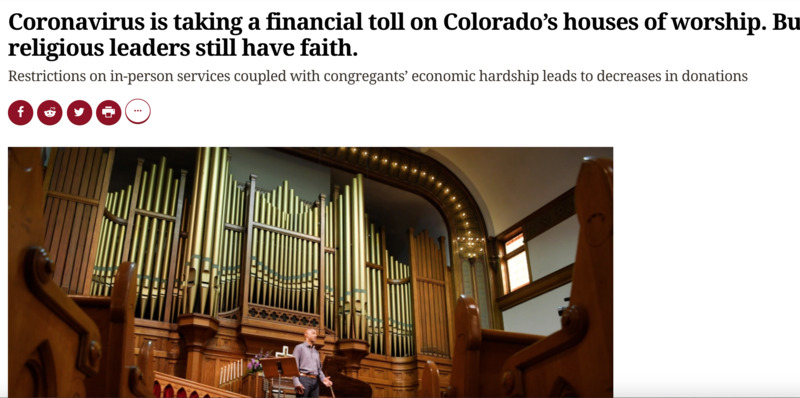 2020-05-17
2020-05-17Coronavirus is taking a financial toll on Colorado’s houses of worship. But religious leaders still have faith.
During the pandemic, many places of faith are on the verge of closing their doors permanently. As people lost jobs, giving obviously declined. Because houses of worship rely entirely on giving, this has created a crisis for many churches, mosques, synagogues, and temples. These houses of faith still have bills to pay, they have employees to pay, and the vast majority of these houses of faith contribute significantly to their community. This article speaks to the uphill battle being faced specifically by places of faith in Colorado during the pandemic. -
 2021-03-20
2021-03-20Oral History: Interview with Anonymous Peace Officer #1
James Rayroux 0:00 My name is James Rayroux. I'm a graduate student in global history at Arizona State University, and I'm working as a curation intern with the "Journal of the Plague Year" COVID-19 archive. Today is March 21, 2021, and it's just after 5pm or 1700 hours here in Arizona. I'm speaking with a narrator who wishes to contribute to the COVID-19 archive anonymously. Sir, I first want to thank you for speaking with me and contributing to this COVID-19 archive. Do you consent to having this interview recorded, transcribed, and immediately posted to the "Journal of the Plague Year" COVID-19 archive, where it will be made accessible to the public? Anonymous Officer 0:39 I do. JR 0:40 Thank you, I greatly appreciate you making time to share your experience with us. In lieu of your name and city, can you provide me with a summary of your background and professional experience in law enforcement? AO 0:57 Yeah, I've been a sworn police officer for a little over 10 years in northern Colorado. I've worked for a couple different departments during that time. I started off at a small municipality, and at one point worked for a state law enforcement agency and then working for a municipality that has approximately 150,000-160,000 citizens within the jurisdictional limits of our department. JR 1:25 Can you give me a summary of your life before law enforcement and what led you to police work? AO 1:33 Yeah, so I grew up with a family of cops, a grandfather and two uncles who were police officers, so I'd always kind of had that in the back of my mind. When I was a teenager, I started working out with an alcohol and tobacco compliance team. So I would go in and attempt to buy tobacco and alcohol products underage to ensure that corporations were properly ID'ing the people who came in to buy those products. I studied criminal justice a little bit in college, although that's not what my degree's in. I went to a police academy and then worked at the departments that I previously mentioned. And then within the realm of police work, my emphasis has mainly been of a traffic safety, impaired driving nature, so that's where my expertise kind of lies within the realm of police work. JR 2:38 What are some of your professional goals over the next few years, and where would you like to, what would you like to accomplish before the end of your career? AO 2:50 My sights in the next couple of years, I'm currently working on a master's degree in organizational leadership. With that degree, I would like to promote within my department to at least the rank of sergeant. And like I said earlier, I work for a larger department. Previously, I came from smaller departments, and I kind of missed that small town feel, so eventually, I'd like to parlay that supervisor experience in my larger department into being a supervisor at a smaller municipality or a smaller county agency where I think I could bring both sides of working for a small agency as well as looking at working for a large agency to help a smaller agency, because they don't usually get a lot of super qualified candidates for the higher positions. It's kind of what is already at the department, which sometimes is great, and sometimes it's not so great, and I think that having somebody that just hasn't came up through that agency to bring some new kind of fresh ideas is really good for us. That's ultimately the goal. JR 3:58 And when and how did you first learn about the SARS-CoV-2 virus in early 2020? AO 4:08 Initially, I heard about it on the news, broadcast news, and then I visited enough websites, mainly Reddit, which is often called "the front page of the internet" that kind of started talking about it and how it was kind of on the West Coast. Obviously, Northern Colorado is more westerly in the US, than, you know, the middle of the country, and Denver, our biggest city in Colorado, obviously has an international airport, and there's lots of things that come through, so I kind of kept an eye on it. Also with the nature of my work, I come into contact with people of all different kinds of races, religions, sexes, creeds, orientations, all of that both, willingly and unwillingly, so I kind of kept my eye out and knowing that there could be a good chance that if it came to Colorado that I would be involved with it just because, traffic stops, disturbances, sometimes we have to take people into custody against their will if they have a warrant, or they're fighting us, so that's a really close contact, like hands-on situation. So I knew if it did get worse, I didn't expect to be this bad, but if it did get worse, that it'd probably end up affecting us in one way or another. JR 5:22 Do you remember what some of the early conversations were like that you had about the SARS-CoV-2 virus or COVID-19, what those conversations at work were like or were about? AO 5:36 Yeah, a lot of them were just kind of like, you know, this is just a really bad flu. As long as you, you know, sanitize your hands after you deal with people, which is a pretty common thing that cops do. I know, the majority of cops that I work with carry around a little bottle of sanitizer, either on their person or in their what we call a "war bag," a little bag that sits in the front seat that holds all our tickets and everything else we need for the shift. So it was initially just, you know, be smart. If somebody's sick, keep your distance if you can, wash your hands, sanitize. And then once summer comes in, because early it was spring, where it's still pretty cold here, that once summer comes, the heat will naturally kill it off, and it's not going to be anything worse than the normal flu was initially the talk around town. JR 6:24 How did your agency first deal with the COVID-19 pandemic? AO 6:30 So initially, we got multiple emails, kind of just updating it from what they've heard from the Surgeon General in Colorado that was disseminated to people higher up in the city side of our agency, with just tips, kind of like what I just talked about, wash your hands, you know, don't touch your face or mouth, sanitize your hands, sanitize your cars. And it was just kind of a more official version of what we all kind of thought, which was that it was just a worse flu as long as you, you know, stay at home with your sick, don't voluntarily interact with sick people, etc, etc, that it would be good and we'd be done by summer. JR 7:13 At what point did your agency start encouraging or mandating mask use by employees? AO 7:23 So I want to say early March is when the governor of Colorado put us on a statewide lockdown. So I want to say maybe mid February to late February, is when we got a order to make sure that we're wearing masks, if we're around each other, if we're going to be in somebody's house. They were saying they prefer it on traffic stops, but they know because of the nature of us standing in traffic and it's kind of already hard to hear that, that was kind of our discretion. But I want to say mid to late February was the big one. It's also when we stopped doing in-person briefings. We have a specific briefing room where our sergeants, commanders will talk to us about what happened earlier in the shift, what they expect of us tonight, just conversations about our shift in general that's usually done in a room. It was about that time that we move that outside. So we all just kind of stood outside our police department and ended it to be a little bit safer than being in the booking room. But even when we did that we still wore masks were outside doing our briefing. JR 8:28 What do you remember or what did that first pandemic briefing or roll call look like when everyone showed up in, in masks? AO 8:37 It was definitely interesting. You know, it's just something that you usually don't see unless you're in a hospital setting, which we obviously go to sometimes if we have bad car accidents or bad assaults. But again, even that's usually if the person is thought to have been sick or something else, where you're obviously not standing in the emergency or the surgery department. So it was a little bit different seeing everybody with these, at the time, surgical masks. We ended up getting given cloth masks and everybody eventually started you know, finding a mask they liked better, but initially, it was just paper surgical mask like you see at the hospital, so it was definitely a strange sight to see twenty cops standing around with their mask on. JR 9:23 How have your agency's policies and procedures changed since that initial response in February 2020? AO 9:31 Um, so as COVID kept going up and more and more cases and especially in Colorado, and especially Northern Colorado where there was a higher outbreak than the rest of the state, we got, I don't know the name of the product but it's essentially a super medical grade cleaning product that is so strong that you have to wear gloves and a mask anyway when you're using it because it can burn your hands and you don't want to inhale it. So we are given directives to wipe down everything we touch on our car. So steering wheel, driver-side door handles, radio mics, computers, shifter, etc, with that cleaning product both before and after our shift. And then our department also bought a bunch of small hand sanitizer bottles for everybody to carry with them. And then we had two big jugs in our, what we call patrol room where we type our reports, that we could refill those smaller bottles with. And then we were given a mandate to wear masks anytime we were in contact with somebody. And if we could, any calls that we were, we can, we would normally take in person, such as like a cold theft or something just for customer service reasons, if we're not super busy, we'll usually go to that person's house and just get their statements so they can have a face-to-face contact. We were given a directive, though, to do all that over the phone as much as we can. So there would be nights that just wasn't a busy in-progress night, and I would take fifteen calls, all from my car parked in a parking lot somewhere. So after a decade of doing this, that was a big difference in what I was used to. JR 11:12 For the benefit of the audience, can you explain what a cold theft report is? AO 11:17 Yeah, so a cold theft report is if somebody came home from dinner, and let's say their son, their twelve-year-old son left their bicycle just outside in the front yard leaned up against the house, they get home and that bike was gone. And they don't have any kind of surveillance systems, you know, they weren't home when it happened, so they know that something was stolen, but they have no idea of exactly when, no real description of who might have taken it, and we call that a cold theft. It just means that it's not something that's in-progress. Like if somebody were to call and say, "Hey, you know, there's actively a fight going on right now at the mall." Um, that would be an in-progress call, or a hot call is what some people call it. Anything cold, so a cold theft, a cold burglary, a cold auto theft just means that it's something that's not actively happening, and they don't really have much information to go on. JR 12:05 Thank you. Do you remember what your first inperson call was after you began wearing masks, and maybe your first call after the public started wearing them as well? AO 12:19 I don't recall the specifics of either. I know that there was a couple calls I went to when you know, we were mandated to wear the masks. And you know, police officers still have freedom of speech just like everybody else does. But, you know, working for any organization, whether public, like the government or private, you still follow the rules and policies, procedures of your police department or your, your company. In this case, my police department or my company said that, you know, there's a new policy that we'll wear these masks. So it was weird, because there are some houses we go to where we would talk to people in-person and, you know, they'd be like, "Well, this is dumb. I don't know why you're wearing this mask. This is essentially the flu, why would you wear it?" You know, I'd have to be like, "Well, you know, my opinion on it is irrelevant. At this point, I'm here for a reason, but my boss told me to wear this, and my department told me to wear this, and that's why I'm doing it." And then we get the opposite where we go somewhere, and we would have the mask on and so would they and they're like, "You know what, I'm really glad that you guys are taking this seriously, and, you know, there's a lot of people that aren't." At that point, they're happy so I'm not going to say anything to change it. But you know, we would give people a mask that would ask us. "I'm glad you guys are doing this. Do you think this is as bad as it is?" And I would say, "You know, well, my again, my opinion on it's irrelevant. My boss told me to wear this mask, my department told me to wear this mask, so that's why I'm wearing it. Anyway, how can I help you with the reason that you called today?" JR 13:53 Has the pandemic changed your sense of security around fellow cops or fire crews or EMS personal? AO 14:02 I don't know if it's so much has changed my sense of security. I know it's changed things that we've, we've done things a lot different. It's not uncommon for police officers and my agency or anywhere across the United States to also be dispatched to fire medical calls. And we provide what's called scene security. So firefighters, a lot of them also double as paramedics and EMTs. And obviously EMTs and paramedics are those things. They have a job to do, and that's you know, rescuing people or providing life saving medical intervention on people. And sometimes especially if it's drug or alcohol fueled, there can be other people on scene that are concerned or upset and they want to get involved with it. And so law enforcement will get dispatched to assist with that and make sure that the scene is safe or secure, so that the firefighters and EMTs can do what they need to do. And usually we'd always go to those. It changed a lot where if somebody was COVID-19 positive or had symptoms of it, and it didn't seem like we needed to be there, we would go to a lot less of those just to keep our officers safe and not put them in unnecessary danger. JR 15:11 Has the COVID-19 pandemic affected your process or procedures for detaining, arresting, or booking suspects or arrestees? AO 15:23 Not so much for detaining or arresting, those thresholds are met at certain times, and for various reasons. You know, so I've detain people before that, I don't think are alleged to have committed crime at that point. But because of their general behavior, or things they've said or things they've done it, they're detained from an officer safety perspective, so they can't hurt us, and they don't hurt anybody else. Obviously, I've detained people because I feel like they may flee from us, and, you know, I have a reasonable suspicion that they've committed a crime, and so they're going to get detained until we can figure everything out. So our department is really great about stressing as far as keeping yourself and your partner safe, nothing changes. So whatever you need to do to make that happen is fine. I work for a municipality, so our "booking standards" is what we call them, so what we can and cannot book people for is set by the sheriff of our county, who runs the the jail. Because of the COVID things, and obviously, you get inmates that are together in tight spaces, and there's a lot of them, he relaxed them, and essentially lowered the threshold of crime that it would take. So in Colorado, we have three different classes of misdemeanor with M-1 or misdemeanor-one being the highest and M-3, or misdemeanor-three being the lowest. Same with felonies, there's one through six, one is the highest sixth lowest, he essentially made it where we can't book on any misdemeanor charges for a while, which are the majority of what we deal with, I'd say. And two, we just cite them into court and give them a summons to court to appear in front of a judge to address the charges that they're alleged to have committed. That was different. So I think that was the sheriff's way of trying to control the inmate population so it just doesn't have as many people packed together. JR 17:18 In the past few months, do you suspect or have you thought that, during your interactions, a member of the public or a suspect or even another officer has attempted to use the pandemic or a possible COVID-19 infection to, to alter your interactions with them? AO 17:42 I don't think I've seen that from officers. We have definitely seen it from people that we've contacted on the street, and especially people that still meet those arrestable jail booking standards. We were told by the jail to ask a series of questions before we brought them in. You know, "Have you been in contact with anybody with COVID recently? Have you tested positive for COVID? Have you been out of the country?" There's a bunch more other ones, and it's pretty easy to kind of tell what we're getting at by the directions, the questions go. And we've had people that have been like, yep, I have COVID, my mom has COVID I've been in contact with them. And they think that that's going to make it where they don't go to jail. In all actuality, all it really did was delay that slightly because we had to go to the hospital. At which point the, the medical staff would give them a quick COVID test if they were running a fever show any outward symptoms. If they didn't show any outward symptoms, they would clear them for jail, which just means a doctor says this person is healthy enough to be incarcerated right now. And then I believe that jail would quarantine them in a separate wing. If they said they had COVID or if they did have a positive COVID test. Jail, for people that don't know, is a little bit different than prison. It's either filled with people that are doing shorter sentences, so like weeks, months sentences, not ever years, or people that have just been arrested on crimes. And a lot of times especially in Colorado, they will quickly get them out of what's called a PR or "personal recognizance" bond, essentially a piece of paper they sign that just says "I promised to come to my court hearings," and if they sign that piece of paper, the jail will release them without paying any money. So the jail would usually try to turn them out pretty quick, so give them that PR bond and get them out of the jail just as a further way to lower the risk to the jail staff and the other inmates that were in there. JR 19:39 Have you had to personally enforce any aspect of COVID-19 pandemic compliance with any member of the public? AO 19:48 No. Luckily, again, our department's been pretty great about things. We got a directive from our chief of police that said you know, "We're not enforcing governor orders," essentially. The businesses have every right to refuse service people that aren't gonna wear masks, and that's fine. If those people you know, then try to assault somebody or, or do something like that, then that's a police issue at that point. But if it's just one of those things where the people won't leave, and they've told them multiple times, he said, we can show up and you know, tell them, "Hey, this is probably business, the owner doesn't want to here. Please leave." But we are given pretty strict orders not to forcefully remove anybody for violating a civil policy from the store, essentially, the police deal with criminal matters. So if you know Guy A punches Guy B in the face that's assault, can't do that, it's criminally protected. If Guy A said he's going to pay Guy B $20, and he does not pay him $20, that is a civil matter. There's nothing criminal they agreed into, or entered into an agreement, so the masks generally fall into the civil matter. So we haven't had too many people, too many issues with it. Stores have refused service, and we've gotten a couple of calls from customers who said that it's a violation of the Americans with Disabilities Act and all the things that people have seen on any "Karen" videos. But generally, when the people say, "Hey, we, we don't want to get you in trouble, please leave or we're going to call the cops," the people left. So we don't have too many issues with it up here. Luckily. JR 21:23 Part of some of the changes that have taken place during this pandemic are the way that people interact with each other, and in Western society, shaking hands has long been a critical foundation of trust in humanity. And I suspect that's probably also true between many cops and the people that they serve. How have you worked to build rapport without having direct human contact? AO 21:51 Yeah, that's actually one of the things that you can tell a cop besides their ages, you know, there's there's officers that get into this career, late life, I got into it pretty early. I was in my very early 20s. And that's a common thing, as you know, me, somebody looked me in the eye and shake their hands. It's pretty easy to tell cops that have been doing this for any amount of time. Because if somebody does that, they usually have the canned response of like, "Oh, no, no offense, I don't shake hands. It's just, you know, a hygiene thing." Most cops are borderline germaphobes, after some of the stuff that we see and deal with, so people understand that even more now because of COVID, which is nice. The, the one that I think every cop has gotten pre and during and post COVID is the drunk guy who was just trying to be cool with everybody, and he wants to shake your hand or give you like a, you know, knuckles, pound it out. You know, we just tell him, "Oh, yeah, no, man, because of COVID we're just not trying to touch anybody." And it's cyclical, like, "Oh, no, man, I get it." Sometimes it turns into like being angry because he thinks we're being rude to him, or he just forgets and then goes back. So usually, for the 99.9%, we just explained that, "you know, because of the COVID and our policies, we're not allowed to touch anybody unless we absolutely have to," and most people are like, "Nope, I totally understand." So they've, our citizens have been really great at understanding that. JR 23:11 What do you miss most about your job and your daily tasks from 2019? AO 23:17 Um...I'm really over sanitizing my car twice a day. It's a process that isn't too long. It's, you know, five, ten minutes, but um, it just adds another checklist thing that we have to do before we start our shift. Cops by personality traits are usually Type A people, so they are very, "This is the way we do things." But that involves getting my gear in the same way it is on my belt and my vest every day, setting my car up the way that I want to set it up, getting logged into our computer, our MDT system. It's just another thing that we have to do. And I work for a pretty busy municipality, so there's times that we'll we'll be called "hit the street" or we come on-duty, and there's already a bunch of calls holding. That means there's no officers at them, and they're just sitting there waiting for somebody to take them and a whole shift is delayed by fifteen or twenty minutes because we're cleaning out our cars and sanitizing them, which is for our and for everybody else's safety, but just another thing that we have to do on top of everything else. JR 24:22 What alterations to your work life, to your daily tasking, do you expect you'll keep from this pandemic, and what do you wish to change immediately? AO 24:35 Uh, I think personally, I like handling a lot of things by phone that don't require an officer in-person. It allows us to be a little more centrally located and if something else big comes up, we can tell the person "Hey, I'll give you a call right back," and we can take off and do that. I also think that there's a lot of people that actually prefer just having an officer call them back because they're at home. They don't, you know, want the officer coming to their home, or sometimes they're not at home, they report something that happened at home when they get to work. So I like that portion of it. I was already kind of a germaphobe before this happened. I think that's probably going to, at a minimum stay the same and if not amplify a little bit more. But just doing a better job personally of, after I've been in somebody's house, even if I don't shake hands with them, just making sure I throw on hand sanitizer, wash my hands, just as a force of habit. No matter how clean and dirty the house is, we just don't know the people generally, so just kind of keeping that cleanliness I think is going to be a big help going forward. JR 25:39 Through this pandemic, and your experience working as a police officer during this time, what do you most wish the public knew about the COVID-19 pandemic, as it relates to your profession and to cops and police work in general? AO 25:58 I think, for us, it's real easy to see every police officer as one entity, just the person with the uniform and the badge. They forget that we also have families that are out, you know, in the same public places, that we have children that go to the same schools as the people that we deal with daily, that all of the stressors that everybody else has from this, this pandemic of not being able to, it's loosening now, but especially last summer and this fall, the same stressors of not being able to go out to eat with friends and blow off steam, or just go to the bar and have a beer with a buddy. We have all those same stressors because, you know, we're cops 40 plus hours a week, but the rest of the time, we're citizens that live in the same community as everybody else. So it's, it's understandable when, when the people that we deal with, you know, think that we're just the the strong arm of the government enforcing these rules that you know, they don't think are constitutional, or whatever it is, but we have to follow the same rules and get the same stress from that on top of having the stress of having to enforce those rules, which whether or not we do or don't agree with them, we have a job do and we signed up to do that. So just wishing that people would understand that we have, we go through all the same stuff they have on both sides of it, on our work side and also on our personal side, and just being a citizen of the same community that they live in. JR 27:21 Now, knowing that I was going to ask you about your experience as a police officer during this pandemic, what question did you most want to answer during this or that you wish I would have asked you during this interview? AO 27:40 I think my biggest one we actually touched on, which was how did the officers feel about the mask mandates and the, you know, various states closing down in-person dining and all that. And my answer, which I touched on, if it was asked directly, was at the end of the day doesn't matter. You know, there's officers are just a small segment of the whole population. You know, we have men, women, gay men, gay women, trans men, trans women, black, white, Asian, Hispanic, those are all actual officers that I work with in every single one of those categories, so they're just a small sample size of the entire agency. So you're gonna have people that are far left Democrat, that are far right Republican, and at the end of the day, our personal beliefs should not and in my case, don't matter. As far as if I believe this is a real virus, if I, you know, think that everybody should wear masks, they don't, you know, we're sworn to uphold the Constitution of our state and our country, and rules and regulations set forth by our municipalities or counties. So just knowing that kind of, you know, you should never know after talking to a cop for any length of time, what their stance is on is on any polarizing subject. So you should never really know what religion they are, if they're religious, what Republic or what political party they lead with. That's one of the, the what I think makes a good cop is they can help anybody, no matter where they're at in life, rich, poor, whatever color religion they are. So realizing that, you know, we have our own thoughts on it, but we still have a job to do. It's just something I wish that people would realize that wherever we stand on it doesn't matter because we're given our policies, our procedures, and we're going to follow those and hopefully that, in the end, will help this get over a little bit sooner and help everybody get back to a normal life. JR 29:44 I greatly appreciate your time and willingness to share your expertise. Thank you so much. AO 29:49 Thank you Transcribed by https://otter.ai -
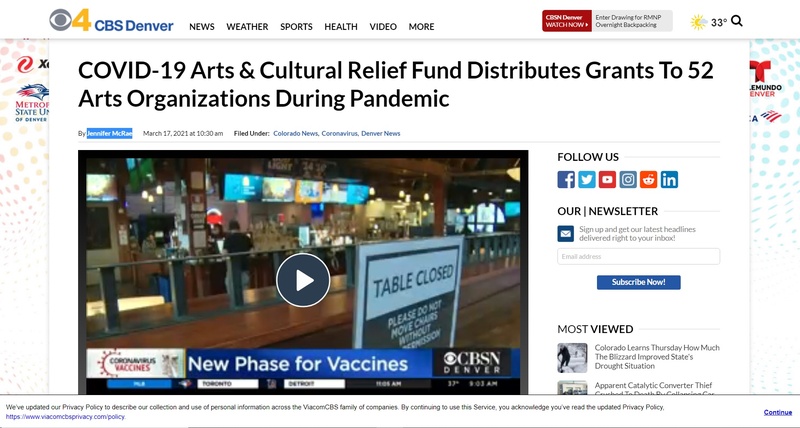 2021-03-17
2021-03-17COVID-19 Arts & Cultural Relief Fund Distributes Grants To 52 Arts Organizations During Pandemic
Performing and visual arts organizations in Denver, Colorado have received more COVID-19 relief funding. This newest round of funding, totaling almost $900,000, comes from the COVID-19 Arts & Culture Relief Fund. -
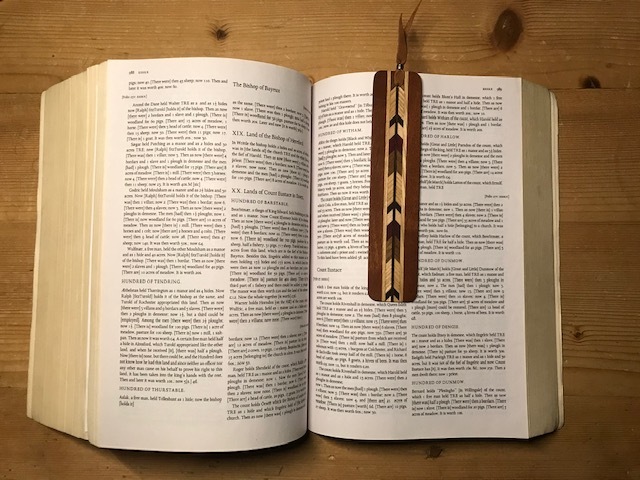 2020-04
2020-04The Historical Research Project
Specifically, the Covid-19 pandemic inadvertently prevented me from my continued work in the Research Department at the Denver Public Library, as well as my volunteer work with the School Tours program at the History Colorado Center. However, it has given me an opportunity to conduct a history research project of my own choosing. I have had an ongoing interest in a writing project on the Domesday Book, which was a survey conducted in medieval England in AD 1085-1088. The repeated news stories on fellow Americans and citizens from around the world choosing to become interested in artwork and/or other projects while presented with an abundance of personal time due to Covid-19 restrictions has inspired me to begin this project. I was able to obtain a copy of an English translation of the Domesday Book and, though my graduate level academic work has not been postponed in any way, I have found time to begin this work. I will always remember that I began this passionate project because of the Covid-19 lockdown and restrictions, it will occupy my time far beyond Covid-19. -
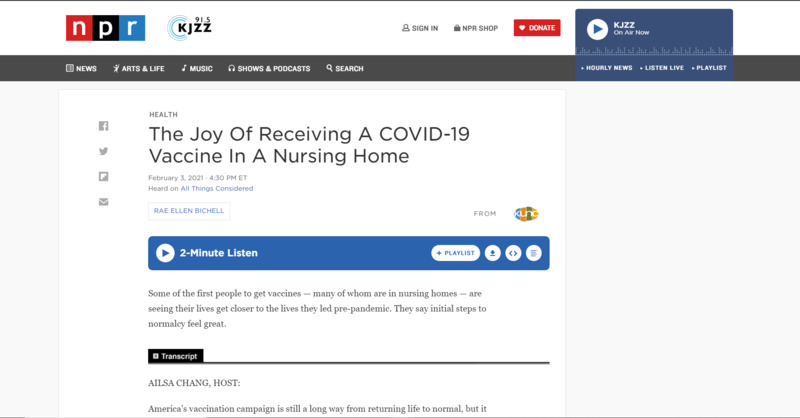 2021-02-03
2021-02-03The Joy Of Receiving A COVID-19 Vaccine In A Nursing Home
Residents at a Colorado assisted living faclity got their second dose of the COVID-19 vaccine. They are now allowed to have gatherings as long as they continue social distance and wear a mask. Their family can also visit them once again as long as certain safety measures are followed. -
 2021-01-11
2021-01-11Pizza and The Old Stone Church
Lockdown restrictions to indoor dining at restaurants, which prevents friends from gathering and socializing in familiar locations. -
2019-12-09
Why Skiing Won't Work in a Pandemic
WHY SKIING WON"T WORK Dear Director Silver Thread Public Health (Mineral County, Colorado), I've had a few days to mull over the response made to my comments to the commissioners earlier in the-week regarding the ranking of Mineral County on the Colorado COVID 19 Dial and dashboard. Though I am not a resident of Mineral County I do spend the better part of my day in the county some 150 days a year, forgive me for commenting again, but I feel duty bound that someone goes on the record in hopes that a different viewpoint might have influence, even if in the back of the mind of the county's decision making as the pandemic progresses. I see some flaws in the reasoning given for gerrymandering Dial levels, rather than using them as they are described: Nowhere on the state’s Dial web pages is the decision process STH is using described or encouraged as its proper use. To say it is for guidelines mostly and not necessarily classification misrepresents the public’s perception and use of the dial. Changing classification to a county’s preferred level interferes with individual and the public’s crucial health options and choices. There is an assumption in the explanation that because Mineral County is a small town that somehow the numbers of incidents per 100,000 would be treated differently. Is the known math of the virus and its tendency for spread somehow fortuitously different here than the rest of the planet? I think not. 1.7 deaths per 100 cases works for COVID whether there are 700 people present or 7,000 people present. Rates per 100, 000 are employed exactly to gauge the seriousness of outbreaks regardless of the size of communities. Dangerous spread in sparsely populated states made up of mostly small towns disapproves Creede’s desire for s special dispensation from the disease. The explanation of ad hoc policies and improvised rankings and guidelines fall on the premise of a Public Health expert’s interpretation of “social responsibility,” an expert completely without the means to accurately monitor or enforce “social responsibility.” Social Responsibility, by the way, is also the governor’s preferred preventative and even his office has acknowledged that it has not worked. As illogical as it is that the smallness Mineral County somehow protects it from the realities of a deadly virus that obeys its own rules (and we know its rules well) no matter where it is transmitting, the wishful thinking that a small town knows best how to make its own rules defies even the remnants of reason when the policies disregard that the county includes a resort where thousands of people have and are gathering. Even if ranking and guidelines (at the time of my comment or now) were helpful per the improvised policies of STH relative to Creede, if that logic holds, the ranking and policies for small Creede certainly could not logically also be applied to Wolf Creek Ski Area, which was and is gets visited by thousands of people per day packed into parking lots in an area about the same area as Creede and at much higher density of people per square foot. Many of the ski areas visitors have come from far flung states with high infection rates, and most are from cities where small town “social responsibility” is often something very different than enjoyed in Creede. (I’ve seen plates from over 20 different states and from literally every corner of the county.) Small town or other norms of “social responsibility” also does not describe the atmosphere or the intent of a ski resort. It’s a vacationland where, in part, people travel a long way to take a break from their normal “social responsibility.” Indeed there is a strong element of maverick independence associated with the sports of snowboarding and skiing--including the apres socializing associated; It’s a place where, expectedly, we are allowed to break the rules a little, or a lot. Even within the community, if the Dial is not accurate, it can be intentionally or unintentionally misused by leadership in organizations and businesses that have to make decisions about gathering. Not everyone understands the elaborate process described in the thinking of STH; even a reader of it might not be helped by its crafting. Some individuals and leaders predisposed to attitudes resistant to the realities of COVID 19 will inevitably use lower ranking to justify their own personal and organizational loopholes. Employers of that bent may use the misinformed ranking or juggled guidelines as leverage over employees who would otherwise be best protected by accurate “Level” and guidelines that adhere to the Dial’s published parameters. Fiddling with the COVID Dial on a county level also ignores what public health experts are saying about the current dangers of the disease and models (which have, so far turned out to be pretty darn true) forecasting a debacle this winter, for everyone, including small towns. Fatalists and skeptics of the virus are using today to deny what we know is going to happen in a near tomorrow. Those tomorrows could be better or worse depending on what is done now. Fiddling for little windows of “freedom” will enable the most likely to spread among us to spread, and delays or manipulations of accuracy will cost lives, lives that in a small town count very, very much to all of us. The danger of taking liberties with vital Public Health information by debating the application and inventively blending the facets of a Dial Level leans towards a see-saw of levels, downgrading too soon too much and upgrading too late too little. I sincerely hope that Mineral County will make more effort to educate the public and leadership how to understand and use the dial instead of explaining (or not publicly explaining) the reasons for toying with and complicating it. It might also cut down on your mail, and relieve Mineral County’s health decision makers from the burden of taking on extra potentially egregious extra-personal responsibilities, pressures and culpability for public health outcomes. Used properly, the Dial is a tool that uniformly makes those responsibilities a matter of conferred, collaborative public policy and record rather than an ever shifting discussion inviting undue blame (or undue congratulation) for decisions that might be identified as personal. My prayers are with you as you make these excruciating decisions, and I pledge my personal social responsibility to your efforts. No need to reply. I know you are busy. Sincerely, Wayne Sheldrake South Fork, CO PS I don’t put this all on STH or Mineral. I know adjoining counties are also picking and choosing from the Dial. All the better reason to keep it descriptive rather than interpretive. W. K. Sheldrake (Wayne) is the author of Instant Karma: The Heart and Soul of a Ski Bum, #1 on Outside Magazine Online’s list of “6 Adventure Books We’d Read Again and Again,” and Foreword Magazine’s ‘Gold Medal’ Adventure Book of the Year (2007). He is recording his pandemic experience in a memoir THE19: Confessions of a Mad (American) COVIDodger. He lives in Southern Colorado with his “high risk” wife where there is plenty of wide open space. They do not currently have a dog. -
2020-12-25
My COVID-19 Christmas
My 2020 Christmas was different but some things stayed the same. I started out my Christmas break finishing online school for the semester. After I took my finals I started packing my suitcase to go to Colorado. I was born there and I have my whole family there. My mom and I go every year to visit my grandparents on their farm. My sister is in college in Arizona so she meets us in Colorado for Christmas. This year was different because she couldn't come to our grandparents house. She had to work. So on Christmas day we face-timed her to open presents and it was very fun. Another thing that changed this year was was the plane. We flew on United airlines and the plane was only half full. My mom and I wore masks and got our temperature taken before we entered the plane. We stayed in Colorado for a week and it was super cold, but there was no snow. After we flew home to California I spent the rest of my break playing volleyball at the beach and binge watching TV shows. -
 2020-12-01
2020-12-01COVID in the Navajo Nation
When I was originally planning my trip, I hoped to visit Antelope Canyon, as well as a few other parks on the Navajo Reservation, but the Navajo Nation has been one of the hardest-hit regions in the country, so by the time I was in the area, the parks were closed, and even if they had been open, I wouldn’t have felt comfortable visiting and spreading it more, even if I would have been outside and away from people. Because of that experience I wanted to take this space to try to amplify their experience. This Instagram account records the experience of an organization providing relief to members of the tribe. There are only 45 search results for Navajo in the archive, which I would constitute as an archival silence considering that many cities with comparable populations have hundreds of entries. I know that taking a screenshot of a website can only tell you so much, but it is the best way I could come up with of elevating the voices of the Navajo Nation, which is an important practice to engage within the context of archival work. -
2020-04
The Pain of Teaching at Home
This is story like many others during this time. The work of a parent with kids sent home for e-learning. Though I had a background in education, having an M.A. in Education, this was a task that was a difficult one that my education and years of teaching could not help me. The first task is explaining to younger children why they have to stay home. Especially when we as adults are unable to truly grasp what is going on. The second part is trying to motivate students to learn when the school was not ready for this type of teaching. Though the teachers tried, the manner of teaching was a difficult one that led great stress during this time. To add to it, the consistency and norm for the children was shattered which required me to try to recreate that same standard, yet another difficult task. Added onto that, is a child that struggles with reading, which most of the assignments were backed by, instead of the lecture they were used to. The first step was trying to set the norm for them. Breakfast, work, break, work, lunch, work, done. Though it sounds simple, with two separate students with different educational abilities, and drive for success, keeping one on task while the other was done or finishing faster was a task. Aiding them was truly difficult. Some of the difficulties came from my teaching experience being middle and high school not elementary. The next being understanding some of the finer points of the material being taught, I found myself having to learn the material to then teach the material to my children. To compound it further, there is the social aspect of being stuck at home with out the interaction they needed for their peers. Though I fancy myself a “cool” dad, I will never measure up to my kids’ friends. Attempting to fill this void was significantly more difficult than being their teacher. Though my kids did not have near the growth they would have received academically while being in school, they did not lose intelligence and picked up some knowledge along the way. Though it took tears, patience, drive and resilience, it was a time that we can all reflect on and hope it never happens again, which it did, 5 months later, but everyone was better prepared and the lessons learned from the springs allowed for greater success on the second go. Here is to hoping it doesn’t happen again!!! -
2020-06-23
An Emptied COVID Border
Being a dual-citizen has its perks under normal circumstances, but was incredibly useful when the United States-Canada border was closed amidst the pandemic. Every summer, my family and I do the road trip from Denver, Colorado, all the way to my grandparents' cottage in northern Ontario. However, this year, all unnecessary travel was completely restricted to non-citizens. Since we are all dual-citizens, we were allowed to enter, given we complete a 14-day quarantine before seeing anyone. It had been almost a year since my Granpa had a massive heart attack, and then survived triple-bypass surgery. Thus, my family and I thought traveling and completing the quarantine would be worth the risk if it meant we got to see them. Masked up, we drove across the Blue Water Bridge between Sarnia Ont. and Port Huron, Michigan. Normally, this bridge would be filled with cars and trucks, backed up in a 30-45 minute long line. COVID changed that. As we approached the border station, there were no other cars or trucks in sight. We slowly entered the only open crossing lane, and eerily, everything proceeded relatively normally. The pandemic killed travel, especially international movement; but I never would have expected to be the only vehicle crossing into Canada. It felt so unnatural and was an abnormal experience I hope I never see again. -
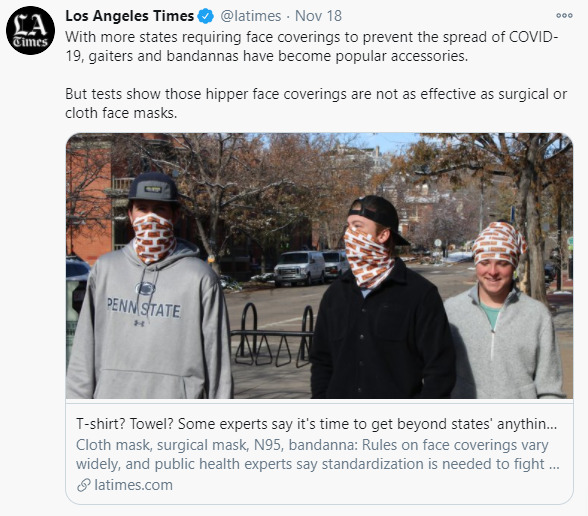 2020-11-18
2020-11-18Time to Standardize Masks with a Mask Mandate
With more states requiring face coverings to prevent the spread of COVID-19, gaiters and bandannas have become popular accessories. But tests show those hipper face coverings are not as effective as surgical or cloth face masks. -
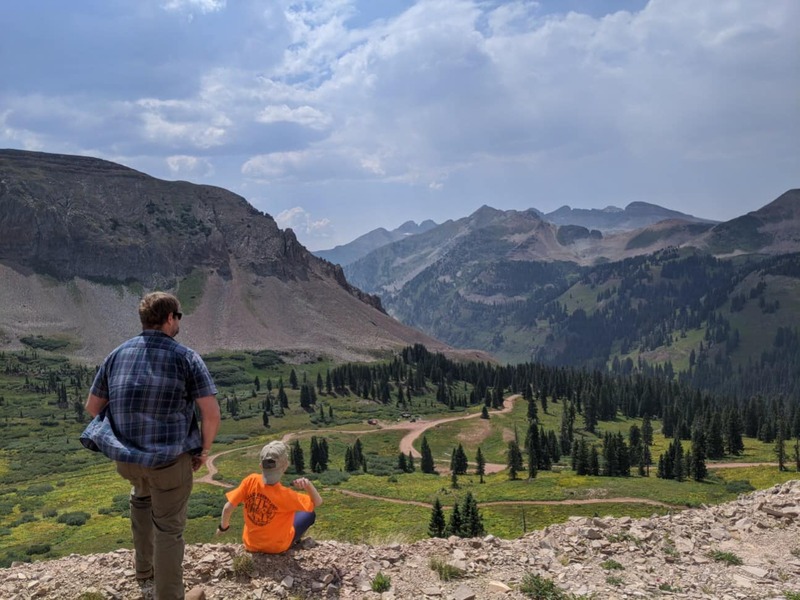 2020-08-20
2020-08-20Get Out!
Even in a global pandemic when everything is shut down, there are still a million things to do and see. This was our family’s trip up Kennebec Pass, which is only an hour from our hose. Covid is the perfect opportunity to explore your own back yard, provided you do so safely! -
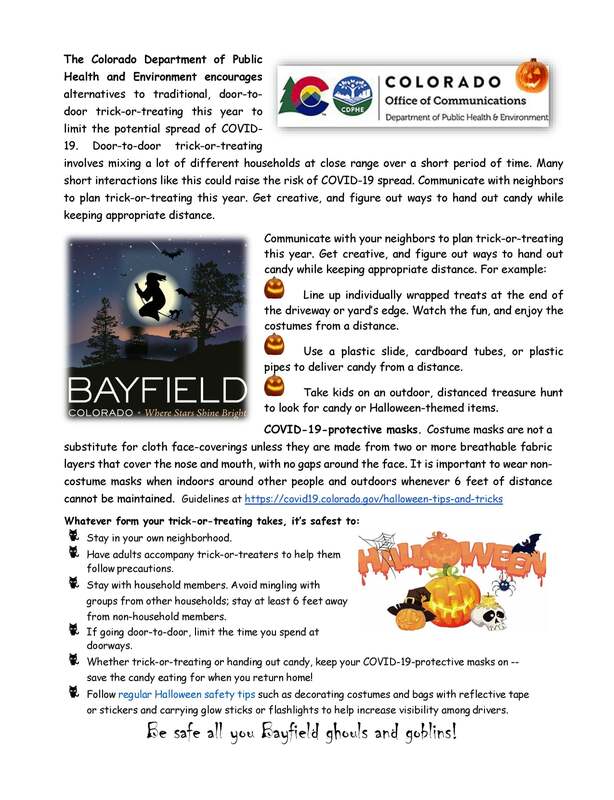 2020-10-09
2020-10-09Adapted Halloween
The Town of Bayfeld has outlined the procedures for Halloween during COVID. -
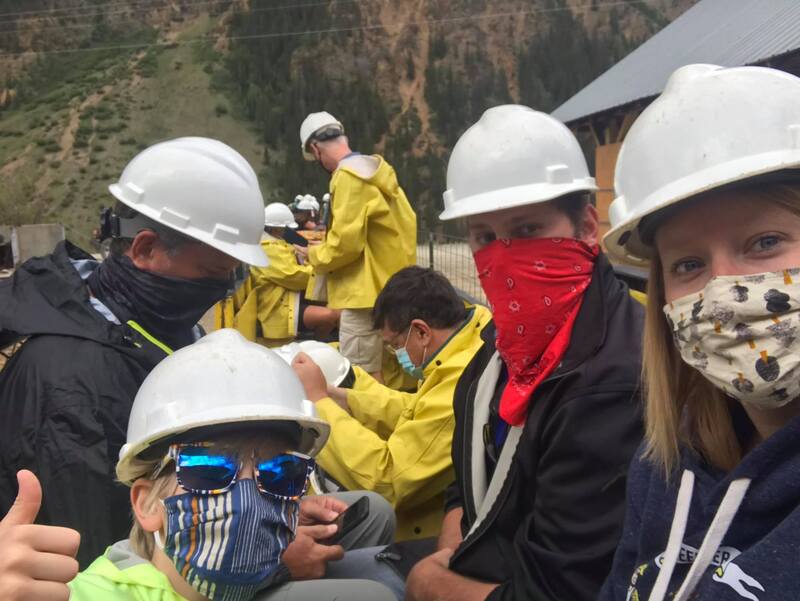 2020-08-08
2020-08-08Extra Protection
When my family and I toured the Old Hundred Mine in Silverton, Colorado, we needed to be protected! In addition the usual hard hat and warm clothing, masks are also required. -
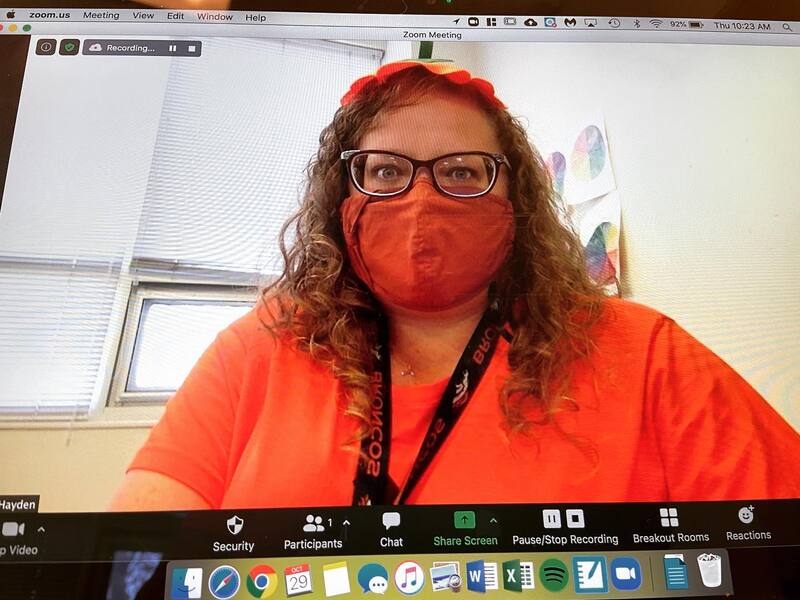 2020-10-30
2020-10-30Teaching Today
This is a photo of my friend, Lindsay. She is a high school teacher here in Colorado. We live in a small town that was fortunate enough to not feel the panic of the pandemic until well-after other places had. She misses her students, and there are real concerns for the mental health of not only the kids, but the teachers too. -
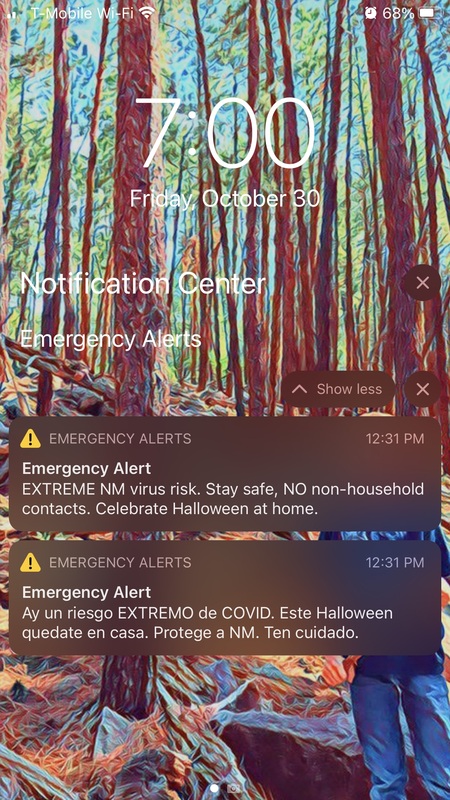 2020-10-30
2020-10-30Concerns From the 4-Corners
This is a screenshot from my phone from this afternoon. I live in Colorado, but depend on New Mexico for several things. I made a quick trip to Target today, and while in the checkout line, everyone’s phones went off. -
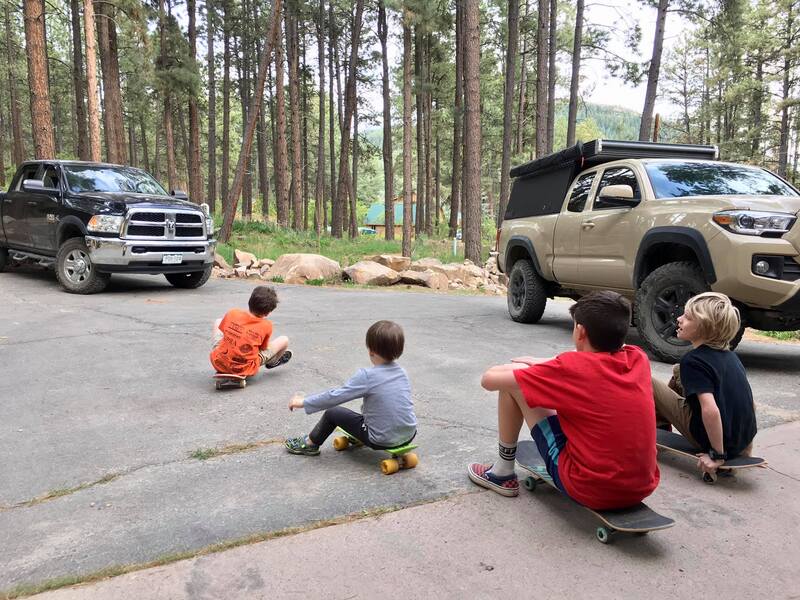 2020-05-20
2020-05-20Birthday Bubble
My son’s birthday was in May. We usually have a big party for him and invite all his friends. This year, by the time May came around, schools were closed so we did not distribute invitations to his classmates like we usually did. Geographically, we live in a bubble. We live in a rural community in a sparsely populated part of the country. So this year, the party was pared down, and took place outside. We invited only a couple friends who all lived within our little neighborhood and we had maintained close contact with since this all began. All went well, and for that I am thankful. -
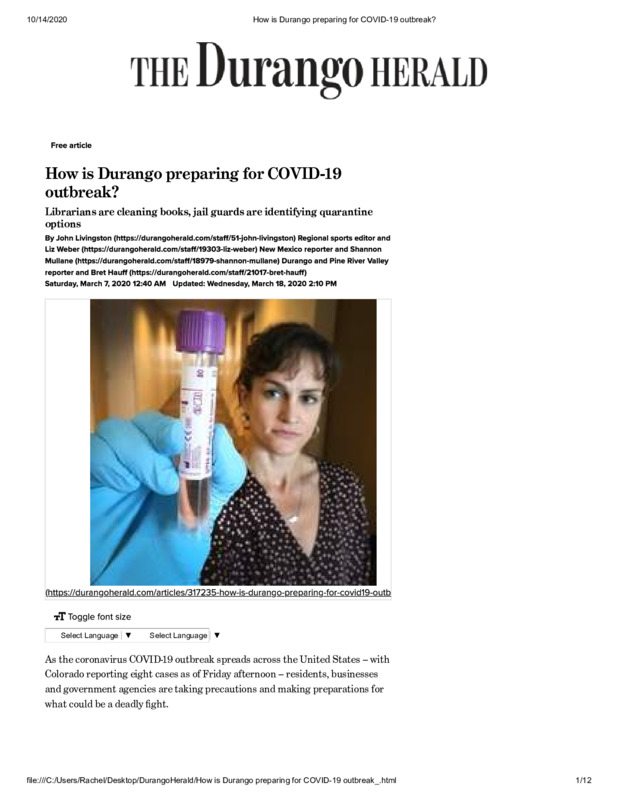 2020-10-13
2020-10-13Real, Rural Concerns
My husband, son and I moved (back) to Durango, Colorado from Monument at the end of February. We closed on our house, started back at school and reconnected with the friends we missed while we were away. Then the news stories started popping up here and there about a new and unidentified virus that is showing up in cities. "Good thing we live here!" I thought to myself. We live in the mountains, in a scattered neighborhood outside a small town in a sparsely-populated area of the country. We'll be fine. My husband's job went to 100% telework. Since he works for the Federal Government, I figured it was just very precautionary and we settled into the convenience of having him home! My son's school went on spring break, more time for playing and friends! I saw on the news that all the schools in Wisconsin (my home state) closed for the rest of the year! Holy cow! I still figured we would not see anything real from this now-named Coronavirus. Then my son's school closed for the year. Suddenly, the entire nation, even our little rural hamlet, came to a shuddering halt. By now, it is into March, nearly April. Tourists still show up to get their last ski runs in, and first hikes and rafting trips of the year in. I suppose that is good. Our entire area relies on tourism so if we can keep things moving, that is a positive, right? Well it turns out there is a pretty huge downside of living in a remote area during a pandemic. Yes, we do not come into contact with many people, we don't have a freeway anywhere nearby, and we do not have a large airport. However, we also lack the resources to have a mass of patients at our hospital. There is one main medical facility that serves a very large area. If this virus shows up here, we could be doomed. With my husband and son home, we hunkered in to see what was going to happen. Fast forward to October, and we have had a handful of cases in our county and neighboring ones, despite the rush of Texas and California tourists this summer. We lost a couple cherished restaurants and establishments, and were not immune to this pandemic. But taking an assessment at the moment, I'm pretty proud of our area. There were arguments on masks, social distancing, sports, and restaurants, that shadowed the nation as a whole, but I saw communities band together like never before. Out of this crisis, there blossomed a new understanding and grace lent to our neighbors that we maybe did not express before. New programs popped up to help those who were struggling, because in reality, we were ALL struggling. This area historically struggles with suicide, and there has been an enormous push to reach out to everyone possible and offer all kinds of hands, or ears as the case may be. All in all, I am proud of my community and I am proud of how we are weathering this storm, among so much other commotion battling for our focus.
